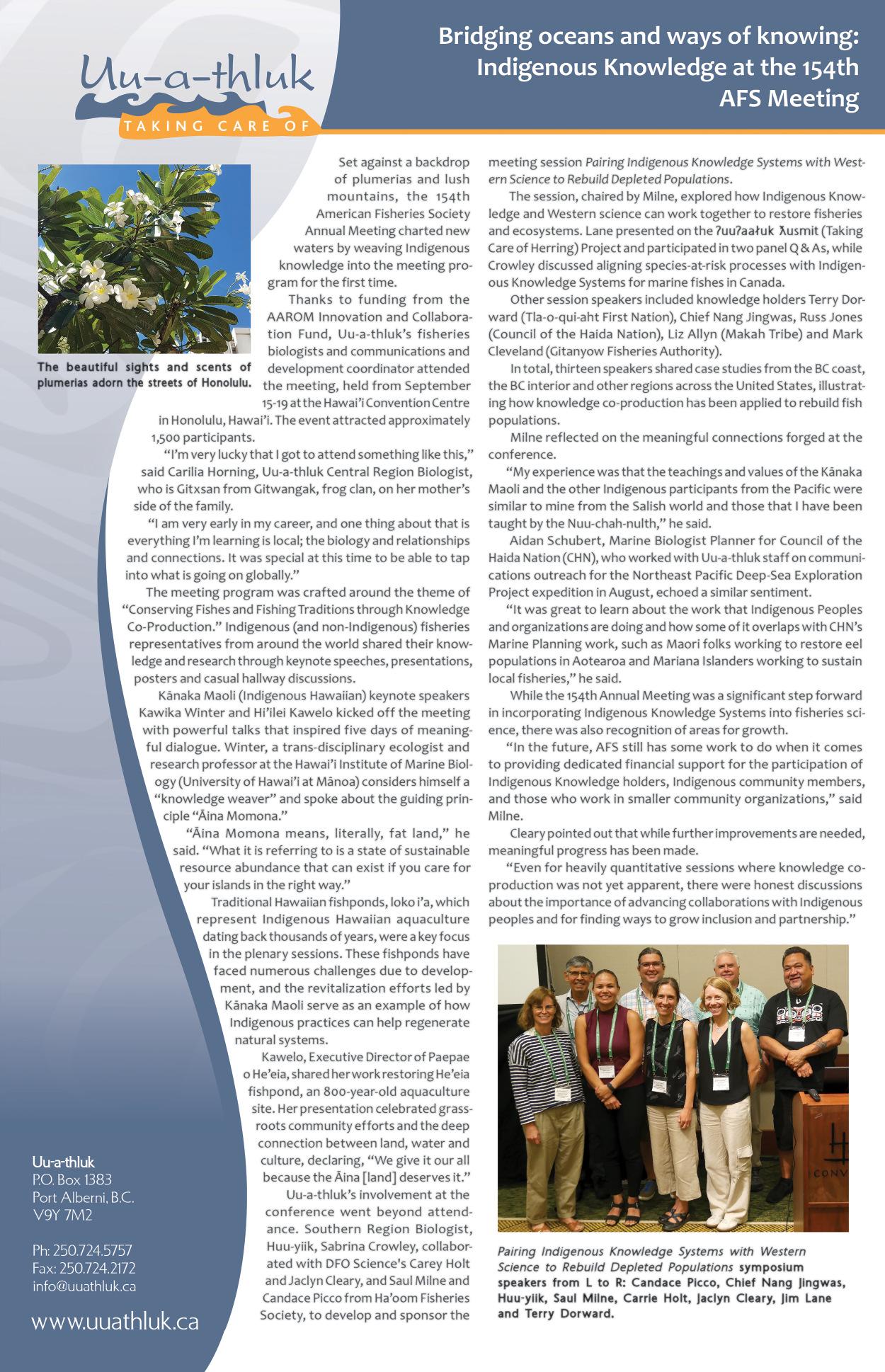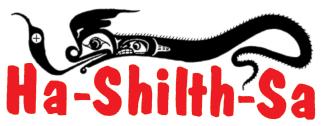

INTERESTING NEWS
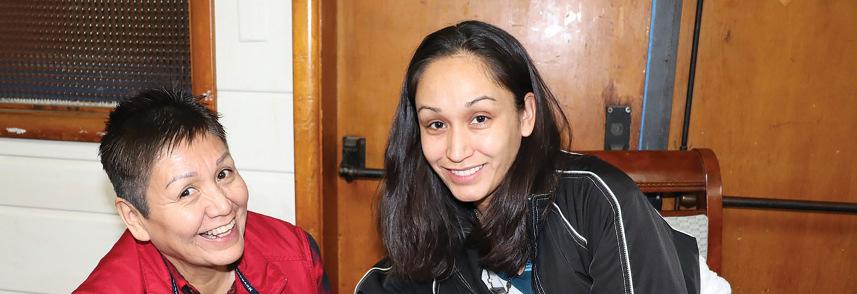
Nine fatal ODs in 11 days after Pandora tents cleared
away from encampment, raising concern for service providers struggling to reach clients
By Alexandra Mehl & Eric Plummer Ha-Shilth-Sa Contributor & Editor
Victoria, BC – In the wake of the policeenforced removal of homeless encampments on PandoraAvenue and Ellice Street, nine members of Victoria’s unhoused population died by fatal overdose over 11 days in November, according to downtown service providers.
Last summer police began to implement a safety plan for PandoraAvenue, which had become home to a large encampment of Victoria’s unhoused, following the July 11 assault of a paramedic responding to a call on the 900-block.
“The situation quickly escalated as a crowd swarmed police and first responders, resulting in a call for emergency back-up from all neighbouring police agencies,” stated the Victoria Police Department in a Sept. 11 update. “During an emergency meeting following the incident, it was determined that Victoria Fire and BC Emergency Health Services would no longer respond to calls for service in the 900-block of PandoraAvenue without police presence.”
One week before the safety plan was implemented, police seized a loaded handgun from the encampment, plus eight knives, two machetes and other weapons. The first month and a half of the safety plan resulted in 50 arrests and the seizure of more weapons, including knives and a rifle. Drug trafficking investigations conducted by police found 330 grams of fentanyl, 191 grams of crack cocaine, 73 grams of powder cocaine and 73 grams of crystal methamphetamine.
“The rising entrenchment and densification of encampments, along with increased hostility, violence, and the presence of various weapons, have heightened public safety concerns,” noted Victoria police. “Additionally, there are growing worries about the victimization of vulnerable individuals within these areas.Aroutine police presence was no longer adequate to address these escalating issues.”
Enacted in mid July, the safety plan aimed to support partner agencies and service providers to eventually remove encampments from the area.
Now, instead of the street being filled with tents and Victoria’s unhoused population, Pandora is lined with fencing, reducing the number of people mustering in the area dramatically.
“Pandora is completely fenced off,” said Karen Mills, co-founder and lead organizer of Peer2Peer Indigenous Society, “in the middle of the boulevard, the
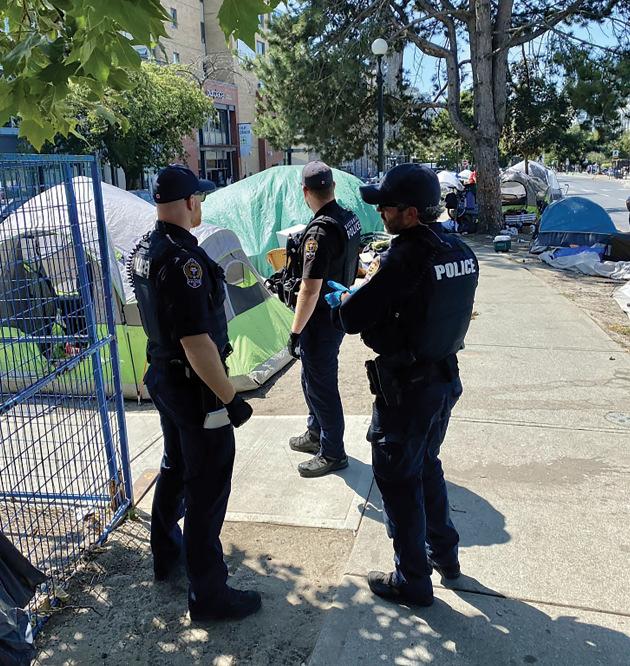
sidewalks, in front of businesses, and so forth.”
“I think anyone going down Pandora now is surprised to see just how few people are still there,” said Julian Daly, CEO of Our Place Society. “There isn’t really much space left to camp.”
In lateAugust, as changes began to take force on Pandora with VicPD’s safety plan, the Ministry of Housing announced the addition of 72 shelter spaces. Since spring a total of 132 shelter spots have been allocated to various organizations in Victoria.
By the end of the summer, Victoria police called the safety plan a success.
“The project has so far been a success in that we are accomplishing our goals of reducing overall entrenchment in the areas, creating a safer environment for those sheltering in the area, for other first responders and for service providers, and building stronger relationships with those in the street community,” said Deputy Chief of Operations Jamie McRae in a statement given Sept. 11. “There are larger issues outside of our scope that need to be addressed by our partners, but we will continue to do our part in improving
safety in these areas of the City.”
Amajor partner in this effort is Our Place Society, which received 40 of the 72 additional shelter spaces announced inAugust. Daly shared that some of the individuals who previously stayed on Pandora have gone to shelters, while others have relocated to other areas in the city.
“My biggest hope is that people will take up shelter spaces when they are offered to them, and get inside for the winter,” said Daly. “Once people get into shelter, then begins their pathway to housing.”
Now Mills is concerned that her clients are dispersed in other areas in Victoria, making it difficult for Our Place to provide the care they normally do.
“We’re spending our outreach looking for people, instead of doing what we’re normally used to doing, which is providing care to everyone,” said Mills.
Given the lengthy time it takes for one of Mills’clients to get in for a doctor’s appointment, get into a detox or a recovery program, or have a housing appointment, not having her clients in a place she can easily locate them has made it
difficult for the Our Place team.
“What is happening to us is these appointments are coming to date and we can’t find our clients,” she said.
But when Mills can’t locate her clients, she worries about overdose.
“When you’re working with somebody… for a very long time and all of a sudden you can’t find them, the very first thing you think of is… that they’ve had an overdose somewhere,” said Mills.
Mills told Ha-Shilth-Sa that within a period of only 11 days in mid November, Victoria’s unhoused population saw nine fatal overdoses. Three of them were Mills’clients.
“We have never had nine fatal overdoses that close together,” said Mills, noting these individuals previously frequented PandoraAvenue. “That’s where all their resources are; that’s their community.”
On the old PandoraAvenue with the supervised drug consumption site, outreach workers available, and a larger population of people who are trained to use Naloxone, Mills said there was less of a chance of fatal overdoses.
Alongside the fencing of Pandora Avenue, three parks in the area are also fenced off, she shared.
“The Indigenous folks that we’re working with, they’re from all over this Island, and there’s actually a lot of Métis people in Victoria that are unhoused,” said Mills, noting that the Peer2Peer Indigenous Society also serves individuals from areas such as Port Hardy, Campbell River, and Tofino.
Peer2Peer Indigenous Society always asks clients if they would like support in returning to their home community, as a means to help alleviate barriers and struggles that may keep them from doing so. Mills shared that they have helped a couple clients return back up Vancouver Island to their home communities.
“Indigenous people, this is their land, this is where they made their community [and] they’re being dispersed to other areas,” said Mills.
“People are getting dispersed, their belongings are being taken, the community [is] divided, people are moving into territories where they’ve never sheltered before,” she added. “They’re out of place.”
Acount conducted on March 7 and 8, 2023 identified 1,665 people in Victoria who were experiencing homelessness, including 282 staying in shelters, 601 in some form of transitional housing and 242 who were unsheltered. One third of these individuals surveyed identified as Indigenous.
Victoria Police Department photo Victoria police conduct patrols on PandoraAvenue during the first stage of the Pandora and Ellice Safety Plan.
Police push homeless
Why 2024 was a bi ersweet year for Tribal Parks
Tla-o-qui-aht Tribal Parks had a banner year, but there’s still a lot of work to do in ge ing business participation
By Nora O’Malley Local Journalism Initiative Reporter
Tofino, BC - Sweetness is the $1 million milestone Tla-o-qui-aht Tribal Parks crossed this year in ecosystem stewardship contributions from Tribal Parks Allies businesses.
Since launching the program in November 2018 with fourAllies and $15,000 in donations, the number of participating businesses has increased to 127. In the 2023-2024 fiscal year those partners contributed a combined total of $444,318 to support Tribal Parks coastal restoration initiatives, salmon enhancement, trail building, community outreach and more. Sweeter still, the late Nancy Powis, a passionate member of the Tofino community, bequeathed 50 per cent of her estate to Tribal Parks, amounting to $1.2 million. The magnanimous gift was put into an endowment fund and a garden with a commemorative bench will be erected along the Big Tree Trail on Meares Island, Tla-o-qui-aht’s flagship hike with some of the world’s oldest cedars.
“I’m proud of where we’ve come and where we’re going. It’s been a busy summer,” said Saya Masso, Tla-o-qui-aht’s Natural Resources Manager and director of the Tribal Parks program, during the Nov. 13 annual Tribal Parks Gathering at Tin Wis Resort. “We hope to do good by all of you, and we hope that you’re all proud and staunch advocates of Tla-oqui-aht Tribal Parks. We hope that you believe in us. We hope that you believe in our rivers and our vision of where we are going.”
Every year, approximately 1.2 million visitors flock to Tofino. B.C., located in the ḥaḥuułi (traditional territory) of the Tla-o-qui-aht First Nation (TFN). With the vision of creating a sustainable tourism model and building strong relationships, TFN Tribal Parks has slowly gained momentum within Tofino’s tightknit business community to participate in a “potlatch economy”.
In traditional Tla-o-qui-aht society, masčim (citizens) contributed what they could as a tithe to their ḥawił (chief), who
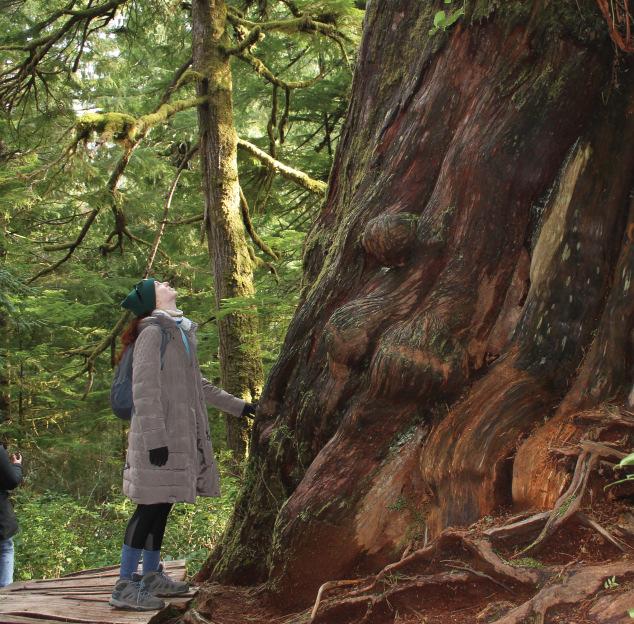
redistributed the wealth. Today, Tribal Parks places an expectation on businesses within their ḥaḥuułi – sign-up to become a Tribal ParksAlly and start collecting a 1 per cent fee from customers.
“The money that is collected here, stays here,” said Masso. “It’s not going to go to Ottawa or Victoria, it’s going to stay here as a legacy to all your grandchildren. We want you all to feel good about that,” he continued.
Speaking the truth is bitter as Masso releases a sigh and talks about the six weeks his Guardians spent monitoring the local rivers for salmon.
“There’s chum, there’s coho, but we didn’t find a single female chinook for our hatchery this year,” he said.
With the new conservancies established in collaboration withAhousaht First Nation and the Province of B.C. to protect
77,600 hectares of coastal temperate rainforest, Masso says he feels “good that our culture will be intact in accessing monumental cedars for our future.”
But the rivers remain broken from unsustainable logging practices and “the cost of rebuilding these rivers is immense,” Masso says.
Tla-o-qui-aht elder and carver Joe Martin echoed the urgency.
“I really hope that more people will support the Tribal ParksAllies.And I really feel that percentage needs to be increased. What that is, is pittance. I think it could be a little more. If you want to come here, you should support,” said Martin.
Masso said Tla-o-qui-aht forwent a longhouse to invest in the protection of Tofino’s drinking water, which flows from creeks on Meares Island.
“We suffer for tourism. It’s unfathomable that a hotel would not sign up to be an ally when their clients are drinking the water from Meares Island that would have been logged and devastated,” Masso said.
Tla-o-qui-aht’s hope is to build a longhouse in Opitsaht, one of the oldest traditional village sites on Vancouver Island, that is large enough to host upwards of 600 people. They would also like to build an athletic hall with two basketball courts and a maternity ward, so they can “bare children in their homeland.”
“We need this for our culture. It shouldn’t be a wish, it’s a need. I hope to get there in my lifetime,” Masso said.
Maureen Fraser, a longtime Tribal Parks Ally and owner of the Common Loaf Bake Shop, was there in 1984 when the original one-page Tribal Parks Declaration of Meares Island was read.
“It was an electrifying experience,” said Fraser.
She said the moment forever transformed her perspective of the land she’s called home for the past 50 years.
“One of the terms used in the declaration is ‘garden’. We in western culture can understand that a garden is something that you have to work hard in. You have to do a lot and you have to protect it, but mostly it’s a place where you do a lot of work in order to be able to live off the proceeds of that garden.And that’s what’s been happening for millennia. That’s what’s happening still now with Guardians,” said Fraser.
In 2024, 40 years after Tla-o-qui-aht ḥawiih (Hereditary Chiefs) declared Meares Island a Tribal Park, the First Nation created a new Tribal Parks Declaration that asserts four terrestrial Tribal Parks within the ḥaḥuułi: wanačas hiłhuuʔis (Meares Island), ḥiłsyakƛis ʔunaacuł (Tranquil and Tofino Watershed), ʔaʔukmin (Kennedy Lake Watershed) and hiisawista (Esowista).
The new declaration also asserts a fifth Tla-o-qui-aht Tribal Park – Deep Ocean, which encompasses the extent of the nation’s offshore fishing and whaling sites.
Nuu-chah-nulth urban gatherings return in December
By Nora O’Malley Local Journalism Initiative Reporter
Fun-filled, family-friendly Urban Community Holiday Gatherings are scheduled up and down the Island, in Vancouver and Seattle this December.
It’s been a good few years since the Nuu-chah-nulth Tribal Council (NTC) hosted the turkey feasts for members living in the cities.
“I’m excited,” said NTC President Judith Sayers. “Urban Gatherings were something that when I first got elected, was an important part of connecting with those living away from home. I really enjoyed going out to each of the cities, talking to people, sharing a meal, some songs and culture.”
The tour of Urban Community Gatherings kicks off with Campbell River on Dec. 3 at the Thunderbird Hall, Victoria on Dec. 4 at the Edelweiss Club, Vancouver on Dec. 10 at the Japanese Hall, Seattle on Dec. 12 at the Seattle Indian Health Board, Nanaimo on Dec. 17 at Beban ParkAuditorium and PortAlberni on Dec. 19 at the Italian Hall.
The gatherings are an open forum for any Nuu-chah-nulth members in the area
and feature a traditional Christmas turkey dinner with mashed potatoes, gravy, cranberry sauce, stuffing, veggies and chumus. In addition to sharing a delicious meal, members have the opportunity to partake in cultural elements like drumming, cedar crafts, brushings and beading.
NTC will also have service booths set up and knowledgeable staff on hand to help answer questions and issue status cards.
“We’re just hitting the main centres. In Campbell River, we can have up to 300 people for dinner. Nanaimo has been growing and growing. We have members state-side in Seattle,” said Sayers. “We’re just trying to pull them together and make sure we have at least an evening with them.”
“I really hope people will come out and enjoy. It’s just our way at the tribal council to reach out to urban members, have fun, have some culture, have some food, you know, just gather the way we used to,” she continued.
For information on the 2024 Urban Community Gatherings, contact the event planner Vina Robinson at (250) 729-1314 or email nuuvisions@gmail.com.
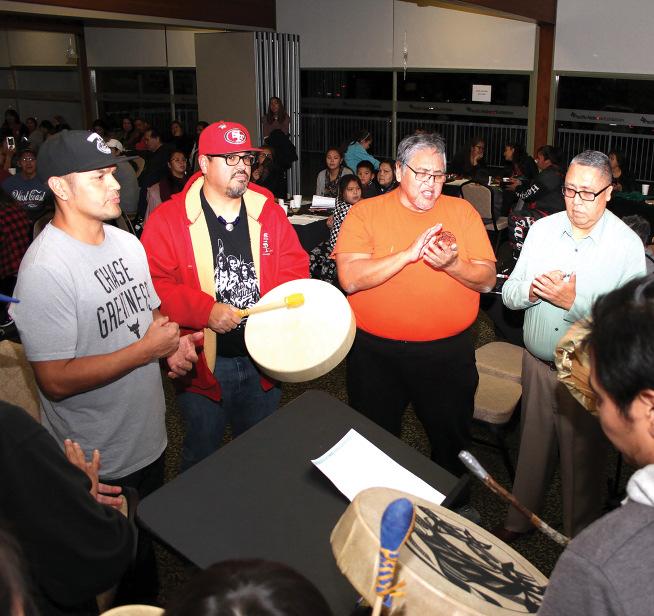
Eric Plummer photo
The Big Tree Trail on Meares Island is part of Tla-o-qui-aht’s Tribal Parks, a flagship hike with some of the world’s oldest cedars.
Eric Plummer photo People sing and drum during an urban gathering in Vancouver December 2019.
Uchucklesaht plans to build housing in empty field
The proposed development on 5th Avenue would see 112 units in a combination of apartments and townhouses
By Denise Titian Ha-Shilth-Sa Reporter
PortAlberni, BC –Aformer school play field should soon be teeming with children again, now that the City of PortAlberni has approved construction of apartments and townhouses behind Uchucklesaht’s Nucii Building on Redford Street.
The Uchucklesaht Tribe Government purchased the former Redford Elementary School in 2018. They renovated the facility, turning it into office and meeting spaces. The playing field behind the property has remained unused for years.
AnAlberni Valley housing needs assessment final report was competed in February 2021. The assessment noted that in 2018 there were at least 147 people experiencing homelessness. It is not known what that number is today.
But other factors are contributing to housing issues, including the low vacancy rate and rising residential housing price tags. TheAlberni Valley Housing NeedsAssessment final report states that low vacancy rates means people must choose expensive or inadequate and unsuitable housing options. With an aging population, more people are living alone
And with bigger mortgage payments, new homeowners are modifying their homes or properties to make additional living quarters for renters, also known as mortgage helpers.
The proposed development at 3830 5th Avenue would see 112 dwelling units in a combination of apartments and townhouses.According to a drawing submitted to the City of PortAlberni, the Uchucklesaht Development Corporation plans to build an apartment building and townhouse structures complete with parking spaces, both surface and underground. The proposal notes there will be

some street parking.
“Our proposed family-friendly 112 units development includes a mix of housing that ranges from studios, one and twobedroom suites in the apartment complex through to one, two, and three-bedroom townhouse units,” said UDC General Manager David McCormick. He went on to say that the development is planned to contribute to the community’s much-needed workforce rental housing stock, “both for those already living in theAlberni Valley who need housing, and for those wishing to move to the community to take jobs in the
skilled trades, professional services and health care fields; as key examples. We know housing is a challenge to attract and retain such needed professionals to the community.”
PortAlberni City Council entertained the proposal for a zoning amendment that would change the lot designation from institutional to residential at a November 2024 meeting. There were concerns raised by homeowners in the neighborhood that there wouldn’t be enough parking for the number of residential units being constructed, and the height of the buildings would impede their views,
but the mayor and council agreed that the need for housing was important.
On November 12, the City of Port Alberni’s council considered the zoning amendment and Official Community Plan amendment for a multi-family residential development at 3830 5thAvenue. The council agreed to give third reading to the amendments, but also put a no-build covenant on the lot until a parking lot was constructed at the neighboring Nucii building.
The third reading will take place at a future City Council meeting. It could receive final adoption at that same meeting.
Runway to reconciliation in Long Beach Airport MOU
By Nora O’Malley Local Journalism Initiative Reporter
Long Beach, BC – With an aerial view of Lovekin Rock holding space in the Pacific Ocean just off Long Beach and endless sightlines of rainforest and mountain peaks, the descent into the Tofino-Long BeachAirport (CYAZ) might be one of the most beautiful landings on earth.
Located within the Pacific Rim National Park Reserve and on Tla-o-qui-aht First Nation (TFN) unceded traditional territory, the Government of Canada built the original CYAZ runways in 1942-1943 for the Second World War.
“The Nation originally supported the development of the airport lands by the federal government with the understanding that these lands and assets would be returned to the Nation at the end of the Second World War,” explained Saya Masso, lands and resources manager with TFN.
In June 2024, over 82 years since borrowing the land, a historic Memorandum of Understanding (MOU) between TFN and theAlberni-Clayoquot Regional District (ACRD), who took over management of the airport in 2000, was signed. The three-year MOU includes the development of a long-term protocol agreement between TFN andACRD that will look at lease applications for the site and develop a communications strategy for the terminal.
“This agreement addresses this griev-
ance and advances the relationship between Tla-o-qui-aht and theACRD and makes efforts towards reconciliation,” said Masso.
Most notably, a new banner that says, ‘Welcome to the Ha-huulthii of the Tlao-qui-aht Ha’wiih’greets visitors as they walk through the doors of CYAZ and a framed copy of the Tribal Park Declaration of Meares Island will be on display.
Alanding fee of $2.50 per ticket has already been implemented, with all fees collected going to Tla-o-qui-aht as part of the MOU of co-operation.
“It’s a really important acknowledgement,” saidACRD ChiefAdministrative Officer Daniel Sailland during a Nov. 21 MOU ceremony and tour of the airport.
“Healing the connection to the land is something that is central to the work that we have to do to move forward together. It’s more than an acknowledgement, it’s an act. That action matters as you can see today and we really want this to be an acknowledgement and celebration with the Nation,” said Sailland.
Tla-o-qui-aht Ha’wiih (Hereditary Chiefs) and representatives of the Hawiih attended the Nov. 21 MOU celebration.
“This is probably the first time that all of the Ha’wiih have been here at the airport since the grievance took place. It’s an honour today,” Masso said.
hawiiḥtaqumł (House of Wickaninnish)
thanked Masso for making these relationships come to fruition and she thanked
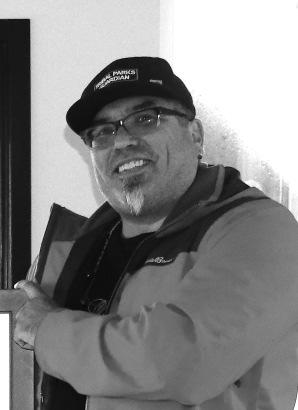
theACRD for recognizing TFN’s unceded land, acknowledging the Hereditary Chiefs.
“We are always against the idea that we had no rights. With Saya’s persistence, things are slowly paying off. We are slowly getting there. It’s a long-haul,” said hawiiḥtaqumł.
“Alot of people aren’t aware that we exist. I recall being kicked out of there when we were kids cranberry picking. You know small things like that,” she continued. “It was great to see this year that we had berry pickers. We sure appreciate that because this used to be a place where we would bring our canoes from
Grice Bay.”
One of the unique features of the CYAZ airfields is the abundance of cranberry patches.
“We had a bumper harvest year,” said airport manager Mark Fortune during a tour of airport lands.
Another neat feature can be seen to this day on the original concrete surfaces: “The aggregate that was used to produce the original runways was dredged from the mouth of the Cypre River. The filters at the concrete batch plant allowed the clamshell debris to be included with the concrete mix. This is why you can still see broken clamshells in the original concrete surfaces at the CYAZ / Long Beach airport,” said Fortune.
There is currently a new hanger under construction at CYAZ, an active float strip for floatplanes and plans for a new terminal are in the works.
The primary runway can handle “large aircraft for emergency purposes”, according to Fortune, and is designated a high ground, safe area. However, as Fortune notes, the site is isolated as the road between Tofino and Ucluelet could be washed out in the event of a tsunami.
Editor’s note: Due to the ‘bomb cyclone’ that hit the coast on Nov. 19, many guests were unable to attend the Nov. 21 celebration, which went ahead despite the power still being off at the airport.
TFN and ACRD look forward to setting up more opportunities to celebrate this partnership in the future.
Conceptual drawing
Through the building of 112 units, the Uchucklesaht Development Corporation plans to build an apartment building and townhouse structures complete with parking spaces, both surface and underground.
Saya Masso
Islanders faced road closures, cancelled ferry sailings
‘Bomb
cyclone’ closes highway routes and cuts off power to 300,000, coastal residents are told to ‘hunker down’
By Denise Titian & Eric Plummer Ha-Shilth-Sa Reporter & Editor
PortAlberni, BC –As the Nov. 19 ‘bomb cyclone’moved away from west coast Vancouver Island, people assessed the damage while others were stranded due to road closures.
The massive storm approached Vancouver Island late in the afternoon of November 19. Environment Canada warned that strong winds continued the following morning with southeasterly gusts reacing 110 kilometres an hour.
One meteorologist stated that a wind buoy located at the north end of Vancouver Island recorded a wind gust speed of 101 miles per hour, or 162.5 km/hr.
The Ministry of Transport and Transit issued a statement on Nov. 19 warning drivers of downed power lines, trees and debris on several roadways. By nightfall, there were several closures, including Highway 14 west of Sooke, the Pacific Marine Circle Route (Lake Cowichan to Port Renfrew), Highway 18 at Hillcrest and Highway 28 between Campbell River and Gold River.
Near Zeballos, the forest service road was closed at the 30 km mark following a landslide. Workers cleared that section of the road by 10 a.m. on Nov. 20, but drivers were warned that a fallen tree at the 7 km mark partially obstructed the road, which remained passable with a single lane.
As the storm died down Highway 4 on both sides of PortAlberni was closed due to fallen trees, not opening for single-lane alternating traffic until the next day. In Tofino, a large cedar tree fell on the roadway blocking Highway 4. This closed the route at Yew Road, with no detour available.
Both BC and Hullo Ferry services were cancelled between Vancouver Island and the Mainland for the morning of Nov. 20.
The trees damaged hydro poles and power lines across B.C., causing over 300,000 people to be without electricity. By noon on Nov. 20 BC Hydro reported that most of these outages had been fixed, although certain areas could still not be accessed.
“Of the more than 300,000 custom-



ers impacted since last night, more than 210,000 customers have been restored,” stated BC Hydro at 11:30 a.m. on Wednesday, Nov. 20. “However, with strong winds expected to continue today in some areas, particularly on Vancouver Island and the Sunshine Coast, further outages are expected.”
Large blackouts remained for Clayoquot Sound communities, Gold River, Tsaxana, Bamfield and Nitinaht for more than a day after the storm.
“Drought-damaged trees and branches came down on electrical equipment during the windstorm causing extensive damage,” noted the power utility. “BC Hydro has had all available BC Hydro crews and contractor crews working since last night, and work will continue throughout the day. Resources will be brought over from the Lower Mainland to
henna artist
By Aleesha Sharma

Book your henna session for community events, weddings, birthday parties, school events or any special event.
Phone: 250-730-1262 or 250-720-3096
E-mail: aleesha_sharma1@hotmail.com


Meanwhile, Hot Springs Cove residents were encouraged to get their emergency kits ready.
“Men will be keeping a close eye on the boats and the dock,” said Hesquiaht Chief Councillor Mariah Charleson on Nov. 18. “The school will be closed tomorrow in case anyone needs to go to the school for any given reason – it will be open for members through the duration of the storm.”
The school in Hot Springs Cove is built high on a hill and was designed to serve as an emergency evacuation/sheltering center for residents of the isolated community.
“Ahousaht has reached out and given us their plan and contacts as they met with emergency management via coordination call,” said Charleson.
TheAhousaht First Nation reminded members that, in the event of an emergency, there would be no access to the hospital or any other medical care outside of the village, and storm conditions make travel out of the community impossible. To attempt to leave the village by boat for an emergency would risk the lives of not only the patient, but also the emergency first responders and boat operators.
support restoration efforts on Vancouver Island today as well.”
Ahousaht was without electricity for two full days after a disruption to the transmission line that feeds the Flores Island community via an undersea cable. According to Curtis Dick ofAhousaht’s Emergency Response Team, the remote island nation prepared for the storm by gathering information from credible sources and working in partnership with manyAhousaht departments.
“We’re reminding people to tidy up their yards and hunker down,” he said, referring to the danger of wind picking up and tossing things like trampolines and other debris.
Aware that this storm would pack hurricane-force winds, Dick was concerned that the term ‘bomb cyclone’may have caused fear.
“Social media is helpful to get information, and we are doing our best to notify everyone, but you have to get your information from a credible source,” he said.
Ahousaht emergency response workers arranged transportation viaAhousaht Fisheries for residents making emergency supply runs to Tofino a day ahead of the storm to get fuel, food and other emergency supplies.
An emergency shelter was set up for residents living in homes that may not be able to withstand the storm.Ahousaht childcare workers set out small cots for children and had sofas and space for air mattresses at their facility.
Cermaq Canada operates salmon farms inAhousaht territory and have staff living on the floating systems during their shifts. Liz Crum, Cermaq’s communications specialist, says they’ve seen these types of storms in the past and have learned from them.
“We batten down the hatches and begin moving loose objects to safe places,” said Crum.
She said the company’s staff were aware of the approaching storm since the weekend and prepared accordingly.
Each site, said Crum, is fully stocked with safety equipment, first aid supplies, food, fuel and water - all part of their Operational Safety Plan.
“We prepare for things like tsunamis and earthquakes,” she said.
Crews keep a close eye on the weather and tides, and managers decide when it is time for crews to head inside to shelter.
Ahead of storms, Cermaq staff step up their safety checks of equipment.
“They usually check things three to four times daily, but when a storm is coming, they triple and even quadruple their safety checks to keep staff, equipment and fish safe,” said Crum.

Lower Mainland District photo
Large trees fell in Cathedral Grove on the afternoon of Nov. 19, blocking the Highway 4 route until the next day.
Coastal residents faced two days without electricity
Tofino and Ahousaht deal with an extended outage after the Nov. 19 storm fells countless trees on power lines
Eric Plummer Ha-Shilth-Sa Editor
Vancouver Island, BC - Two days without power,Ahousaht and Tofino residents headed into their third night without electricity, as BC Hydro works to recover transmission after the worst storm the utility has seen in almost six years.
As of mid-afternoon on Thursday, Nov. 21, Tofino, the Tla-o-qui-aht communities along Long Beach andAhousaht’s village of Maaqtusiis on Flores Island were without electricity, which was eventually restored for most in the region by 8 p.m. In the afternoon of Nov. 19 power was cut to the coastal communities, along with approximately 300,000 people in B.C., when strong winds mixed with heavy rain caused trees to be uprooted across the province.
By 5 p.m. on the following day, power had been restored to 80 per cent of those affected, but all of Clayoquot Sound remained in the dark. Power didn’t return to Ucluelet until the following morning on Thursday.
Called a ‘bomb cyclone’by meteorologists who delivered warnings as the storm approached, the hardest hit areas were on Vancouver Island, where winds off the west coast reached 170 kilometres an hour, according to Ted Olynyk, community relations manager with BC Hydro.
“This certainly ranks up there in the top couple of storms that I’ve seen,” he said. “It spared no one on this island, really, especially those exposed in the coastal areas.”
In PortAlberni residents were without power for approximately an hour on the evening of Nov. 19 as the storm wind howled overhead, causing 25 power poles in the small city to be damaged by falling trees.
“The Beaver Creek area is just a real mess,” said Olynyk.
Westbound the damage was more severe, where countless uprooted trees challenged hydro crews working day and night to restore power to communities in Clayoquot Sound. Things were particularly bad along the stretch of Highway 4 between Ucluelet and Tofino.
“Damage is pretty significant, especially by the junction area. We’re sending more crews over from other parts of the island to help out with the work,” said Olynyk at midday on Thursday. “We hope to have most customers up, but there’s going to be pockets we may not

get to. Working over in the area that feeds Ahousaht, I’m not sure of the timeline of that just yet.”
Asubmarine cable stretches from Tofino across the ocean floor to Flores Island, where theAhousaht village of Maaqtusiis went without power for two full days after the storm. The remote community coordinated trips to Tofino for fuel to run generators and power non-electrical appliances. In the community’s Thunderbird Hall movies were screened and meals served, tables lining the large building for the coordinated feasts.
“We have been doing our best to make direct contact with the BC hydro frontline workers for an update, no answer back thus far,” stated Curtis Dick from Ahousaht Emergency Response in an online update given on Nov. 21, noting that he had heard from the provincial government. “Emergency Management Climate Readiness has also called us and will be making contact to BC Hydro for an update status of our hydro. So please be patient and as soon as we hear anything we will pass it along to the community.”
Efforts to restore power to Clayoquot Sound were challenged by highway closures during the first few hours of the storm, when fallen trees blocked land passage. Some BC Hydro personnel living in Tofino and Ucluelet were able to respond quickly, but others could not access the west coast power lines due to
Highway 4 being blocked until the morning after the storm.
Further south on the coast Bamfield andAnacla were without power for over a day. The blackout lasted 43.5 hours, according to Huu-ay-aht member Stella Peters, who saw extensive damage from the wind and rain blowing over trees.
Fortunately, most people in the coastal Barkclay Sound region have wood stoves, propane appliances, diesel generators and canned food in storage, she said. It’s a lesson that has remained from the December 2006 storm that cut off power to the region for nine days, she said.
Over 250,000 people in the province lost power at the height of that storm. The weather event battered the Pacific Northwest, notably knocking down thousands of trees in Vancouver’s Stanley park, while Peters recallsAnacla’s household water source being cut off for five days due to the electrical disruption.
“Stanley Park made the news ‘cause trees came down, but we didn’t make the news,” she commented.
Judi Thomas remembers that 2006 storm well, as it also affected the Ditidaht First Nation village of Nitinaht on southwest Vancouver Island. Nitinaht also went for two days without power following the Nov. 19 storm.
“Our staff are really pulling together and we have warming stations in the community and hot soup going out,” said
Thomas, who is chief councillor of the Ditidaht First Nation. “The Economic Development Corporation has gone the extra mile to make sure the store is open for warmth and their internet access as well. They’ve got a generator set up at the store running, keeping people warm and fed and socializing to keep some semblance of peace and a little bit of normality.”
The First Nation ran generators to power three internet sources to ensure connectivity in Nitinaht, which does not have cellular phone coverage.
Like other remote west coast communities, power outages are a regular occurrence during the stormy months in Nitinaht. Thomas said approximately 80 per cent of the village’s residents rely on non-electrical sources of heat, such as wood or propane stoves.
“Alot do, and then again there’s a lot of new people in the community that aren’t familiar, so it’s a learning curve for them,” she said.
Another part of life in the region is clearing the road to Nitinaht of vegetation to ensure a safe passage for others.
“Usually there’s trees down all over, but locals out of Nitinaht and community members, they drive the routes to make sure that they have a power saw in the back of their truck,” said Thomas. “They limb and cut and move trees out of the way. It’s become a way of life for people at Nitinaht to be prepared with power saws, candles, emergency food sources. They’re pretty resilient people.”
This month’s storm has been a challenge for coastal residents and the power utility, but for BC Hydro the worst weather event in the province’s history remains a December 2018 deluge and gale.At its height more than 750,000 people in B.C. were without power due to wind from multiple directions uprooting trees from ground that was already saturated by days of heavy rain.
As winter storms continue, BC Hydro works year-round to prevent more lines from being disrupted.
“We do pretty extensive vegetation management, making sure we clear the trees, vegetation that can contact our lines,” said Olynyk.
He reminds people to be cautious around downed lines that could still be live.
“If you see a downed line, stay 10 metres back,” urged Olynyk. “Aline may not have tripped out when it hit the ground.”
CYPRESS RESTAURANT & LOUNGE

Nora O’Malley photo
On Nov. 19 a storm felled countless trees along Highway 4 between Tofino and Ucluelet, cutting off power to communities throughout Clayoquot Sound.
Ha-Shilth-Sa newspaper is published by the Nuu-chah-nulth Tribal Council for distribution to the members of the contributing First Nations, as well as other interested groups and individuals.
Information and original work contained in this newspaper is protected by copyright and may not be reproduced without written permission from:
Nuu-chah-nulth Tribal Council P.O. Box 1383, PortAlberni, B.C. V9Y 7M2.
Telephone: (250) 724-5757
Fax: (250) 723-0463
Web page: www.hashilthsa.com facebook: Nuu-chah-nulth’s Ha-Shilth-Sa
2024 Subscription rates:
Non-Nuu-chah-nulth,Ahousaht, Ehattesaht,Toquaht and Ucluelet members are subject to a yearly subscription fee of $40 in Canada, $50 in the US and $60 for overseas. Payable to the Nuu-chah-nulth Tribal Council
Manager/Editor/Reporter
Eric Plummer (Ext. 243) (250) 724-5757 Fax: (250) 723-0463 eric.plummer@nuuchahnulth.org
Reporter
Denise Titian (Ext. 240) (250) 724-5757 Fax: (250) 723-0463 denise.titian@nuuchahnulth.org
Reporter
Nora O’Malley (250) 266-1584 Fax: (250) 723-0463 nora.omalley@nuuchahnulth.org

Audio / Video Technician
Mike Watts (Ext. 238) (250) 724-5757 Fax: (250) 723-0463 mike.watts@nuuchahnulth.org
EditorialAssistant
Holly Stocking (Ext. 302) (250) 724-5757 Fax: (250) 723-0463 holly.stocking@nuuchahnulth.org
DEADLINE:
Please note that the deadline for submissions for our next issue is Dec. 6, 2024
After that date, material submitted and judged appropriate cannot be guaranteed placement but, if material is still relevant, will be included in the following issue.
In an ideal world, submissions would be typed rather than hand-written. Articles can be sent by e-mail to holly.stocking@nuuchahnulth.org (Windows PC).
Submitted pictures must include a brief description of subject(s) and a return address.
Pictures with no return address will remain on file.Allow two - four weeks for return.
Photocopied or faxed photographs cannot be accepted.
COVERAGE:
Although we would like to be able to cover all stories and events, we will only do so subject to:
- Sufficient advance notice addressed specifically to Ha-Shilth-Sa.
- Reporter availability at the time of the event.
- Editorial space available in the paper.
- Editorial deadlines being adhered to by contributors.
LETTERS and KLECOS
Ha-Shilth-Sa will include letters received from its readers. Letters MUST be signed by the writer and have the writer’s full name, address and phone number on them. Names can be withheld by request.Anonymous submissions will not be accepted. We reserve the right to edit submitted material for clarity, brevity, grammar and good taste. We will definitely not publish letters dealing with tribal or personal disputes or issues that are critical of Nuu-chah-nulth individuals or groups. All opinions expressed in letters to the editor are purely those of the writer and will not necessarily coincide with the views or policies of the Nuu-chah-nulth Tribal Council or its member First Nations. Ha-Shilth-Sa includes paid advertising, but this does not imply Ha-Shilth-Sa or Nuu-chah-nulth Tribal Council recommends or endorses the content of the ads.
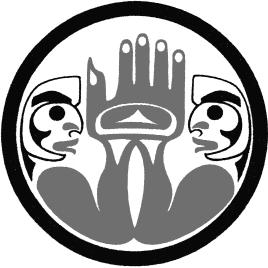
Greens MLAs emerge as ‘special teams’
Two elected Greens look to hold NDP and Conservatives accountable in Victoria
By Nora O’Malley Local Journalism Initiative Reporter
Newly elected BC Green Members of the LegislativeAssembly (MLA) Rob Botterell and Jeremy Valeriote round off the legislature like special teams in the Canadian Football League.
Playing neither offence or defence in a parliamentary battlefield consisting of 47 NDP and 44 Conservation MLAs, the BC Greens are the third-party duo British Columbians can look to for shaping the game.
“I’m willing to work with anybody who has good ideas, solid principals and wants the best for British Columbia and British Columbians. I’ll definitely be working with all the MLAs. I truly believe that all 93MLAs should be working together. That’s the way I’ll want to do the job,”
said Valeriote, the West Vancouver-Sea to Sky MLAand a geological engineer who made history when he became the first provincial Green Party member to be elected in the Lower Mainland.
Valeriote says the Greens are “breaking the mold” of what a political party is and vowed to bring forward new ideas while holding both NDP and Conservatives accountable.
“We really have no business building new fossil fuel infrastructure in the middle of a climate emergency,” Valeriote said. “This is the not the direction we need to go. We need to invest in renewable energy and the energy transition that everybody knows is coming. I would say the four-year blip in U.S. might give us an opportunity to invest where others aren’t investing,”
Sonia Furstenau, Green Party of BC leader and former MLAfor Cowichan Valley from 2017 to 2024, weighs in.
“We have a lot of good ideas in our platform and we’ll be continuing to push the government to look at them, especially on health care, affordability and climate change. We will also continue to provide constructive criticism and feedback on government legislation and look for opportunities to introduce our own legislation,” she told the Ha-shilth-sa in an email.
“One of the most critical roles we play as a third party is making sure we don’t revert to the polarized, two-party system as we see in the United States,” Furstenau
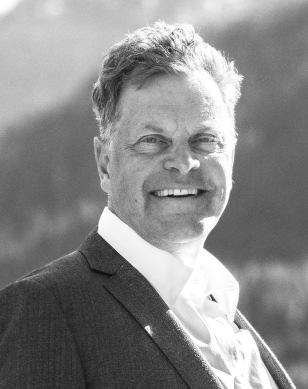
continued. “The BC Greens will work to hold everyone in the building to a higher standard so our Legislature can be a place for substantive debate on ideas rather than toxic political games.”
When it comes to reconciliation, Botterell, the Green MLAelect for Saanich North and the Islands, has a long history of working with First Nations governments in private law, including representing the Nuu-chah-nulth Tribal Council (NTC) in lawsuits.
“He knows us. He understands the issues,” said NTC president Judith Sayers. “The Greens have been a main voice for so many things.”
Tsartlip First Nation memberAdam Olsen was a Green MLAfor Saanich North and the Islands from 2017 to 2024. He says the previous NDP government took an important step towards recognizing Indigenous rights in B.C. by passing the Declaration on the Rights of Indigenous PeoplesAct (DRIPA).
“This was a historic milestone, signalling an intent to align provincial laws with the United Nations Declaration on the Rights of Indigenous Peoples (UNDRIP),” said Olsen in an email.
“However, intent is not the same as action. The implementation of DRIPAhas often been slow and uneven, and there have been instances where the government has failed to uphold its commitments, particularly in the areas of meaningful consultation and consent,” he said.
Sayers re-iterates.
“I recognize that they have to represent everybody’s interest, but I think consul-

Ha-Shilth-Sa belongs to every Nuu-chah-nulth person including those who have passed on, and those who are not yet born.Acommunity newspaper cannot exist without community involvement. If you have any great pictures you’ve taken, stories or poems you’ve written, or artwork you have done, please let us know so we can include it in your newspaper. E-mail holly.stocking@nuuchahnulth.org. This year is Ha-Shilth-Sa’s 50th year of serving the Nuu-chah-nulth First Nations. We look forward to your continued input and support. Kleco! Kleco!
tation and accommodation are kind of old school and we need to move to free, prior, and informed consent,” she said.
“I think there is progress that can still be made. Joint management, shared management… the mechanisms that are in the
“We need to invest in renewable energy and the energy transition that everybody knows is coming.”
~ Jeremy Valeriote, BC Greens
legislation are onerous and they need to be changed so we can do it more easily.”
Olsen suggests that developments like the Haida Nation’s ‘Rising Tide’title agreement, which he says established certainty through recognition rather than litigation, should serve as a model.
“The BC Greens believe this framework—grounded in true partnership and reconciliation—is the way forward,” said Olsen.
“The work ahead is significant, but with leaders like Rob Botterell and Jeremy Valeriote in the legislature, the BC Greens will continue to amplify Indigenous voices, hold the government to its promises, and work toward a future where reconciliation is not just a buzzword but a lived reality,” he said.
Sayers wonders why the Haida TitleAct hasn’t been done for every single First Nation.
Olsen and Furstenau tabled several key private member bills during their time as BC Green Party MLAs.
In 2023, Furstenau tabled legislation to prohibit the use of NDAs in cases of harassment and discrimination, aiming to prevent their misuse in silencing victims.
In that same year Olsen put forward the ‘Repeal of the $10 Freedom of Information (FOI)Application Fee’to eliminate the $10 charge imposed on FOI requests, advocating for greater transparency and public access to information.
Olsen also introduced legislation in 2022 to protect bear dens, which serve as critical habitats for hibernation and rearing cubs, from destruction due to logging activities.
While an exact date has yet to be announced, the first formal session of the 43rd B.C. Parliament will likely be in mid-February.
Legal Information
The advertiser agrees that the publisher shall not be liable for damages arising out of errors in advertisements beyond the amount paid for space actually occupied by the portion of the advertisement in which the error is due to the negligence of the servants or otherwise, and there shall be no liability for non-insertion of any advertisement beyond the amount paid for such advertisements
Jeremy Valeriote
NEDC celebrates 40 years of making dreams come true
The Nuu-chah-nulth Economic Development Corporation has grown from $244,000 to over $65 million in assets
By Denise Titian Ha-Shilth-Sa Reporter
PortAlberni, BC – It has been 40 years since NEDC (Nuu-chah-nulth Economic Development Corporation) began making dreams of young businesspersons true when they launched an innovative model of support services.
According to their website, NEDC is an Indigenous Financial Institution (IFI) providing developmental lending, business financing and support services to Aboriginal entrepreneurs on Vancouver Island. NEDC plays a major role in helping First Nation communities on Vancouver Island become healthy, wealthy and socio-economically independent.
Prior to 1984, Nuu-chah-nulth people were hard-pressed to find business startup loans from conventional lenders.
Under the leadership of the Nuu-chahnulth Tribal Council, the Nuu-chah-nulth Economic Development Corporation was established in 1984 to provide the people with access to commercial financing. Its board of directors initially included one representative from each of the 14 Nuu-chah-nulth Nations and one from the Nuu-chah-nulth Tribal Council.
Over the years, NEDC supported early projects such as the Nuu-chah-nulth Smokehouse Ltd. and the NTC Tree Seedling Nursery. It was there to support the entrepreneurs that launched notable businesses like House of Himwitsa in Tofino in 1990 and Braker Electric in Port Alberni in 1992.
Other Nuu-chah-nulth businesses that were supported by NEDC areAlberni Colour Corner Ltd., which has operated for nearly 20 years, several businesses by the Maqutusiis Hahoulthee Stewardship Society, Pacheedaht Forestry Ltd., Tiicma Hospitality in Kyuquot and Totem Tree Service in PortAlberni, among many others.
NEDC hosted a celebration at Tigh-namara on November 7, where past and present staff, board members and clients gathered to celebrate 40 years of growth and success.
Lisa Watts of Tseshaht emceed the event. She reminded the people what it’s like to launch a new business.
“There’s struggles, success and then there’s the feel of that first win,” she said.
“We are here to reflect on the great successes – it was 40 years ago when some thought we couldn’t run with the big dogs, but we did it!” said Watts.
Before leading off with a couple of songs, Nasimius Ross of Tseshaht recalled being a young 19-year-old man
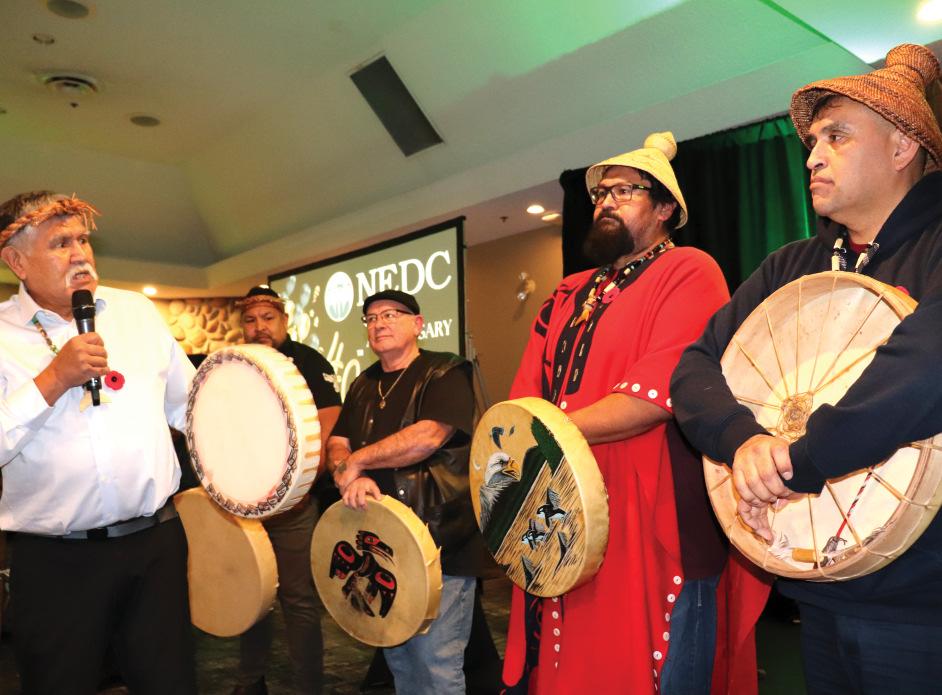
NEDC hosted a celebration at Tigh-na-mara on November 7 for its 40 years of growth and success.Ahousaht
Maquinna (Lewis George) invited others to join him in the singing of the Nuu-chah-nulth song at the event.
when he first walked into the NEDC building hoping to launch his new business.
“Having someone believe in me was huge!” said Ross.
Ahousaht Tyee Ha’wilth Maquinna (Lewis George) invited singers to join him in the singing of the Nuu-chah-nulth song.
“My father (Maquinna – Earl George) gave this song to the NTC to start all meetings with this song.” he said.
Giving a history of the origins of the song, Maquinna explained that it is a warrior song.
“It says we are not afraid of you. We are warriors.And we have been saying this to the provincial and federal governments for years,” he added.
Nuchatlaht CouncillorArchie Little has served as a director at NEDC for years.
He thanked his nephewAl Little, NEDC general manager, for helping Indigenous entrepreneurs when they had no where else to go.
“We believe in them and we will find a way (to help them),” said Little. He went on to thank the Ha’wiih and
staff of the NEDC saying that it is awesome to see and to be part of the success.
Another special guest invited to speak was former Uchucklesaht chief councillor Charlie Cootes, who has been there since the beginning. In 1984 the NEDC’s inaugural board was made up from a member of each of the NTC First Nations. There were 15 board members whose mandate was to assist Indigenous entrepreneurs to achieve socio-economic independence through financial assistance and business advisory services. They started with $244,000 in assets.
Cootes said he saw NEDC grow over 40 years.
“It’s not easy,” he said as he thanked ManagerAl Little for recognizing what the board needs to make things better. He went on to say that the success at NEDC is not only a reflection of hard work, but also a testament to the resilience and spirit of the Nuu-chah-nulth people, who continue to bounce back from the impacts of colonialism.
NEDC, said Cootes, gave access to commercial financing for Indigenous people.
“When the banks were not there, the NEDC was there to help support Indigenous entrepreneurship and economic independence,” he stated.
“As we reflect on the past we look to the future with excitement, knowing we can adapt to the evolving needs of our entrepreneurs,” said Cootes.
Over the years, the NEDC separated from the political arm of the Nuu-chahnulth Tribal Council. In 1999, construction of the NEDC building began next door to the Tseshaht Market on the Pacific Rim Highway. The building project was overseen by local contractors Les Sam (L. Sam Construction) and Cliff Braker (Braker Electric). NEDC officially opened its new facility on September 22, 1999, celebrated with a ribbon-cutting ceremony led by the late George Watts. With more than $65 million in assets, NEDC continues to offer financial and business support to not only Nuu-chahnulth-aht, but also all Indigenous entrepreneurs with viable businesses on Vancouver Island. NEDC supports businesses located in Vancouver, Chilliwack and Salt Spring Island among other places.

Denise Titian photo
Tyee Ha’wilth
A nomadic youth: Generations later, stories surface from the Indian
From 1951-92 an estimated 40,000 Indigenous children were removed from their families to board in faraway households, resulting
By Eric Plummer Ha-Shilth-Sa Editor
When he was about 16 Lyle Billy was travelling alone on a bus from Gold River to Victoria. In his pocket was an address for a home in upscale Oak Bay, a neighbourhood he had never been to.
“Here we go again,” thought Billy at the time. “There was nobody there to help me, there was nobody there to give me directions. I was just on my own.”
With no one meeting him at the bus depot, the teenage Billy had to somehow find his way to the Oak Bay home, where he would reside as a boarder while continuing high school. There were two otherAboriginal boarders there.
“It was the weirdest place,” recalls the Ehattesaht member. “We weren’t allowed in the kitchen, not even to bring in our dishes to the sink, we had to leave them on a little TV table in the living room. We sat on the couch, and the couch was covered in plastic.”
“We weren’t allowed to sit on the other couches, just the plastic-covered one,” he added.
Agrowing teenage boy, Billy recalls being hungry sometimes, as the boarders weren’t allowed snacks after school. But the hosts always prepared lunches for the boys to take in the morning.
“I never saw the people, it was weird,” says Billy. “I had to find my way to the high school.”
This was one chapter amid a nomadic youth.After spending his early childhood with parents in Queen’s Cove and Ehatis, the government-ordered succession of relocations began with a four-year stint at Christie Indian Residential School. Billy got to stay with his parents for Grade 6, where he could walk to the local school in Zeballos, but after a year an Indian agent ordered him to move again, this time to the Lower Mainland to live at the St. Mary’s Indian Residential School in Mission.
Then at the age of 13 Billy was sent to live with the family of a United Church minister in Tahsis.
“They were pretty good to me. They took me on field trips, they didn’t leave me at home,” he remembers.
At that time he was the only First Nations student in the local school, where most of the children were friendly, except for a bully.
“Had a few run ins with him,” says Billy.
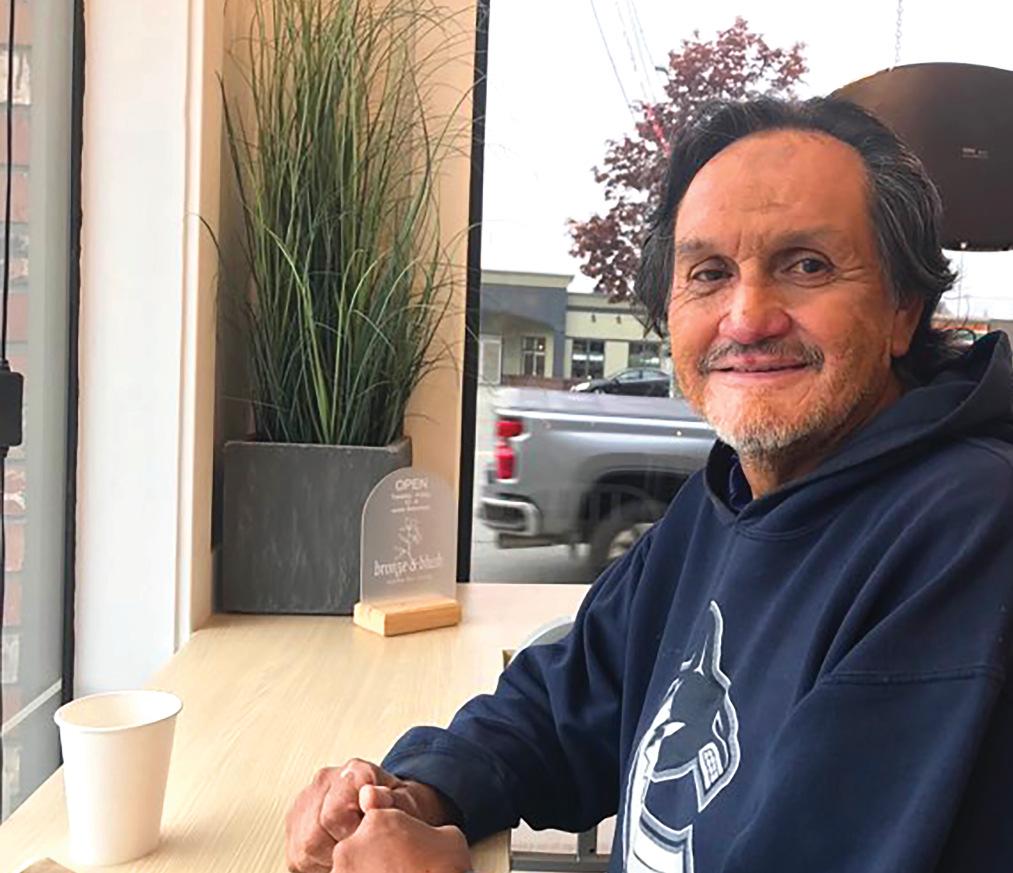
Lyle Billy is one of the thousands of Indigenous youth who were removed from their families to board at other homes as part of the Indian Boarding pictured here in PortAlberni.
“Alot of the kids were really friendly, I made a lot of good friends there.”
Billy returned to Zeballos to live with his parents for Grade 8, but the same Indian agent eventually discovered this, sending the teenage boy to the anonymous hosts in Oak Bay. Several other boarding homes followed, most being better than the Oak Bay residence.
“I wound up staying at this place where my nephew was,” recalls Billy of another boarding home in Victoria. “The guy, he was in the Navy, so he was never around. And the lady, she had two kids, so she was always busy with them.”
“She cooked for us when she could. She
made a nice lunch and stuff, but she was mainly taking care of her own kids,” he says. “I was able to go into the kitchen and make myself a snack.”
‘Totally in the dark’
As he fondly remembers his family’s home, where he spent the best years of an otherwise itinerant youth, it was never explained to Billy why he had to keep moving. Like thousands of people in his generation, he was subject to the Indian Boarding Home Program, a federally mandated initiative that ran 1951-92. The program entailed Indigenous children being moved from their on-reserve homes to
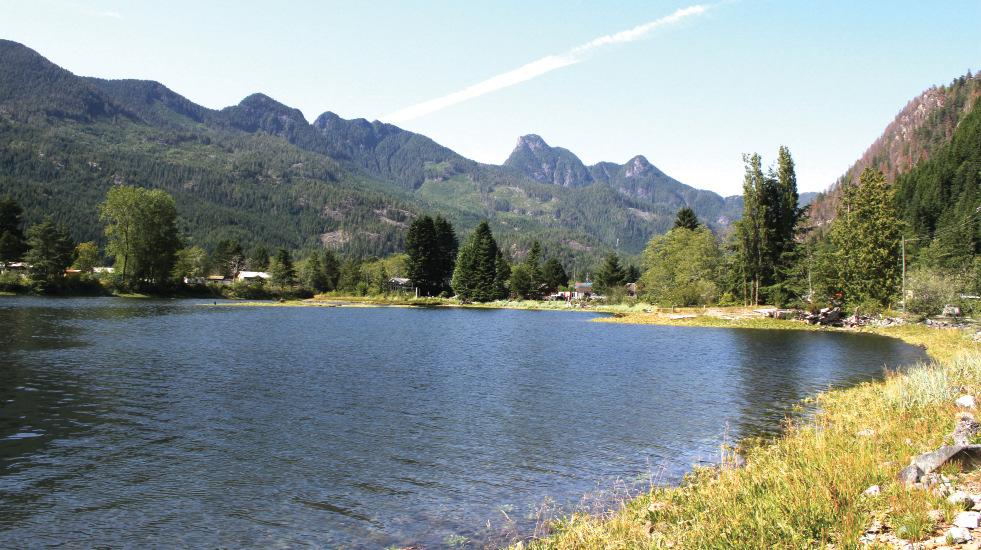
live in households in another community where a school was nearby. Host families received a monthly payment to take in the children.
“The start of it was largely because the Indigenous communities ran out of schooling,” says Darrin Blain, a lawyer with Eagle Nest. “They didn’t have a junior high or they didn’t have a senior high, so the kids had to go somewhere. That was the thinking.”
But Billy did have a school near his family’s home in Zeballos, something

Eric Plummer photo
Lyle Billy spent his early childhood in the Zeballos area, which includes Ehattesaht’s on-reserve community of Ehatis.
Male students say prayers before bed at the Christie Indian this photograph from the 1960s.
from the Indian Boarding Home
ay households, resulting in a large class-action se lement to unfold

Eric Plummer photo homes as part of the Indian Boarding Home Program. He is
that continues to confound him to this day.
“I’m totally in the dark, there was no information,” he says.
Billy encountered some prejudice during his years as a boarder, like an elderly host couple’s adult son who threatened him. Others in the boarding program faced worse abuse.
“There’s a lot of people who talk about this cultural shock, this going to a nonnative family’s home, not being treated respectfully or properly,” says Blain, who is collecting statements from former
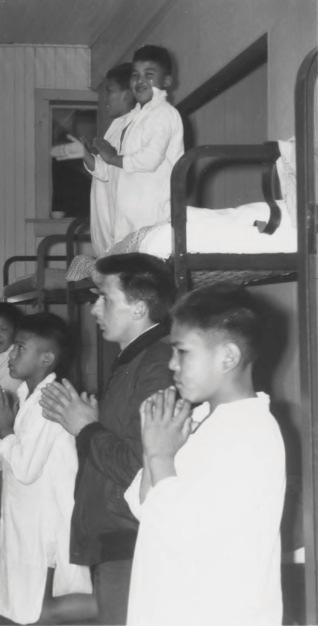
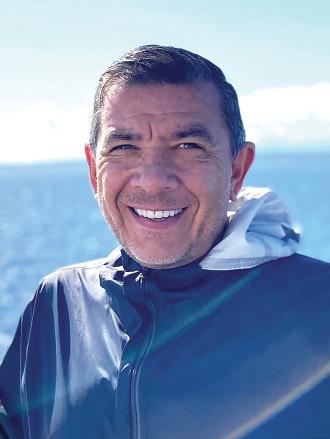
boarders for a class action settlement. “The stories vary from, ‘I really liked it. I was fed three wonderful meals a day and they were really, really nice people and I got an education’, to horrific stories of physical, cultural and sexual abuse. Unfortunately, on the Island, the claims, I think they’re worse out there.”
In June 2023 the federal government announced that the Percival class action had reached a settlement, after a growing number of former boarders were able to convince the Federal Court of the historical injustice of the relocations. Ottawa has so far announced a $50 million investment in “commemoration, healing, language and culture”, but with 40,000 possible claims, the total value of the settlement has been estimated to be as much as $1.9 billion.
“These children, now adults, recount stories of isolation, and many who returned to their family home years later report no longer being able to connect meaningfully with their community,” reads a Federal Court decision from Justice Peter Pamel.
“[T]heir stories speak of an entire generation of Indigenous children being severely damaged – physically, emotionally and psychologically – losing their culture, language and connection to family and community.”
“We’ve got clients who were young mothers, impregnated by the people who were supposed to care for them,” notes Blain. “You’ve got some really talented people and some really, really beautiful people, and just trashed by the system.”
The case was brought forward by Reginal Percival, who has advocated on the matter since 2006. Born in Gitlaxt’aamiks in 1955, Percival’s parents hid him from federal agents to avoid residential school. But one week after Percival’s father was killed in a logging accident, at the age of 13 the boy and 500 other Nisga’a children were sent on buses from their home in the Nass River valley to Vancouver, where they would be matched with boarding families.
Court records recount Percival’s host family often saying they “were getting back their taxes” by taking in boarders.
“When Mr. Percival first met them, they threw his bag in the back of their pickup truck and told him to climb in the back with his bag,” states court records. “Mr. Percival’s boarding home parents discouraged any contact with his family and denied Mr. Percival any reasonable opportunity to practice his Nisga’a language, culture, customs, heritage and traditions. He was also denied any reasonable opportunity to practice hisAboriginal rights as a Nisga’a member.”
Years of discrimination and abuse followed at Johnston Heights Secondary in Surrey, where Percival wasn’t allowed to
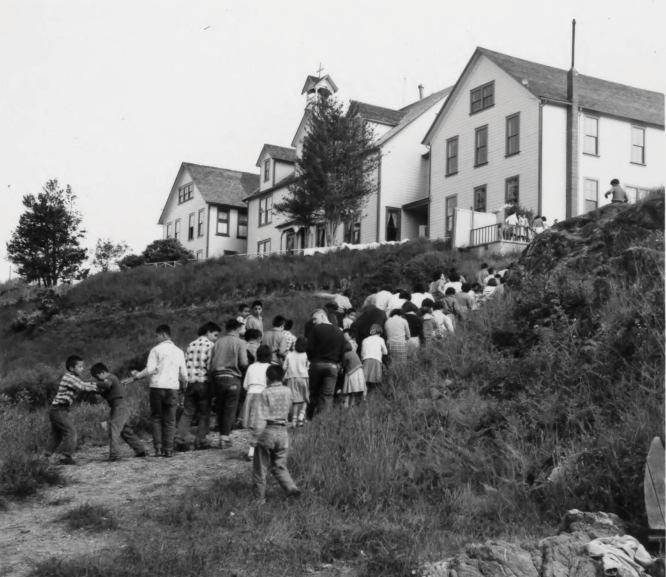
play sports. He turned to alcohol to deal with his pain, according to court records. Fortunately for Billy, while away from his family he found a refuge in basketball, and even joined The West Coasters during a stint in Nanaimo, playing with other boys from Hesquiaht,Ahousaht and Ehattesaht backgrounds.
“We formed a team, and we played in a lot of tournaments up and down the island. It was awesome,” remembers Billy. “I really got into sports to occupy my time.”
Alife-changing ultimatum
Despite the hardship of his adolescence, Percival went through post-secondary studies, and got a job with the Union of BC Indian Chiefs.At 34, he finally returned home to live in Gitlaxt’aamiks again when he secured a position with the Nisga’a HealthAuthority.
Billy also found a career as a young man. The tide of his youth changed partway through Grade 12 with the passing of his mother. He returned home to Zeballos, and had been in the family home for a month when his older brotherArthur gave him what would turn out to be a life-changing ultimatum.
“He said after dinner one night, he said, ‘Look it, I don’t want to see you laying around on the couch. I don’t want to see you doing nothing. There’s only two ways this can go: You either get your ass back to school, or you look for a goddamn job’,” recounts Billy. “He didn’t sugar coat it.”
The younger brother wrote a resume on a piece of paper, and brought it to the office of the local logging company. The next morning his brother came home to tell Billy he would be starting work the next day. Billy filled the role of a choker, which entailed scrambling through fallen timber to attach a cable so logs could be pulled up by a machine.
“I entered into a whole new world,” says Billy. “I was able to learn off of my older brothers. They taught me a lot.”
Looking back on his youth, the 69-year old recalls a tumultuous 12 years – except for two months each summer and the two years he was able to live at home with his parents. Ironically, he credits the most frightening times of his childhood at residential school for instilling a sharp listening ability.
“I figured out the way to stay out of trouble was to do the work, then you’re not getting strapped, because I saw so many of our people getting strapped with the ruler or the yardstick,” he says.
Compensation for successful boarding home claims ranges from $10,000 to $210,000, depending on the severity of abuse suffered. To be eligible a claimant must have lived with a host family that received federal funds for the Indian Boarding Home Program, and this excludes provincially funded child welfare placements. Those interested in making a claim can contact Darrin Blain at 1-888-654-5291.
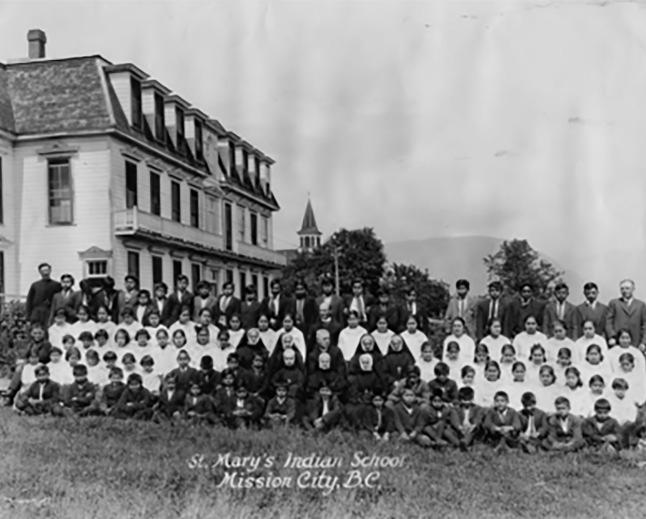
Darrin Blain
National Centre for Truth and Reconciliation photo
Lyle Billy’s childhood relocations began with a four-year stint at Christie Indian Residential School on Meares Island.
National Centre for Truth and Reconciliation photo
St. Mary’s in Mission B.C., one of Canada’s first residential schools.
e bed at the Christie Indian Residential School, in
1960s.
Tofino and region faces high rate of sexual assault
Island’s west coast residents gather to address sexual violence, reported to be vastly higher than other regions
By Nora O’Malley Local Journalism Initiative Reporter
Tofino, BC - Under a canopy of warm holiday lights from within Tofino’s community hall, dozens of West Coast residents gathered for a day-long workshop to take meaningful steps towards ending sexual violence.
Hosted by the Clayoquot Biosphere Trust in partnership with the Westcoast Community Resources Society (WCRS), the urgency of the November 18 gathering was tied to an alarming crime statistic – in Tofino and the neighbouring Nuuchah-nulth First Nations communities of Ty-Histanis, Esowista andAhousaht, the rate of sexual assault is vastly higher than other municipalities.According to crime statistics gathered by police, the Tofino region saw a rate of level 1 sexual assault that was three times greater than reported in Whistler over the past four years, and much higher than Ucluelet and PortAlberni as well. Last year the Tofino region had 346.5 level 1 sexual assaults per 100,000 population, compared to 162 for Whistler, 191 in Ucluelet and 200 in PortAlberni. Level 1 sexual assault includes attacks of a sexual nature that do not cause physical injuries.
WCRS Executive Director Laurie Hannah says the police-reported incidences of sexual assault from 2019 to 2023 are split evenly between Tofino and the offshore community ofAhousaht, located about 40-minutes by boat from Tofino’s First Street Dock.
Hannah thinks Tofino’s “huge influx of seasonal employees” might contribute to the area’s relatively high rate of sexual assault, but notes that the region’s historical lack of services for survivors could likely have a lot to do with it as well.
“There has been an acceptable culture of rape on the West Coast, whereas you go to many other communities like Whistler, the Sea to Sky has had a SexualAssault Response Program for over 10 years. Ours is very new so we haven’t had these community conversations yet,” she said.
WCRS launched its own SexualAssault Response Program (SARP) about a year ago. SARP is a free and confidential service for survivors of all genders that offers the option of third-party reporting,

which means victims can share their story in a safe way and inform the police about the crime without them knowing your identity.
“There is no time limit for when you can report,” said Jenna Pearce, WCRS SARP co-ordinator.
According to research conducted by Adam Cotter at the Canadian Centre for Justice and Community Safety Statistics, the odds of sexual assault being reported to police are about 80 per cent lower than for other violent crimes. This research indicates that only six per cent of sexual assaults are reported to police, making it the most underreported crime measured in the General Social Survey on Victimization.
One of the most common reasons people do report, says Pearce, is to prevent it from happening to others.
“Survivors continue to want to protect others, and this is one of the most beautiful resilient things that I get to witness,” Pearce said.
“As I have had the privilege of hear-
Phrase†of†the†week:†t’i@asum>,†+iicuu
ing the courageous stories of survivors, I’m reminded that this journey to ending sexual violence requires all of us,” she continued. “Together we can amplify these voices, we can address the unique barriers that we experience on the west coast, and we can build a future where safety, justice and healing are more than just ideals – they are realities. Let’s make today a meaningful step towards ending sexual violence.”
Some Tofino accommodation providers are taking proactive measures to create positive workplace cultures that foster respect. WCRS has conducted in-person sexual harassment and consent training for staff at Tofino Resort + Marina and this past spring, Pacific Sands Beach Resort launched a QR Code reporting form for bullying and harassment.
“The idea is very straightforward. We recognized that some people are more comfortable communicating virtually than addressing concerns in-person,” said Linc Solante, Pacific Sands employee relations manager for the last two years.
Pronounced ‘tee ah soom, kleetsoo’, it means ‘winter solstice, feast time’Supplied by ciisma.
“We just want to make sure there is an accessible and discrete way for staff to report things to us. That would also help us to investigate promptly and efficiently,” Solante said, noting that the form is posted on the Health and Safety board and on all common staff rooms.
During the peak summer months, Pacific Sands can have up to 69 employees living in staff housing.
“It’s pretty hectic having to manage housing that big. I have help; there is a head of household, a health and safety coordinator, and I’m just proud that even if we have a large number of employees living on site, I would say our incidents are zero to minimal,” said Solante. “I think it helps that staff know that staff accommodations are tied to their employment. If they break a rule, there is a risk for them to get evicted.”
Tofino’s Nov. 18 Vital Conversation on SexualAssault Response and Consent also included presentations from Hillary McLeod, a certified sexual health educator with School District 70, and Tana Thomas and Chris Seitcher from Kackaamin Family Development Centre.
Located in PortAlberni, Kackaamin is one of three Indigenous Family Treatment programs in Canada. Kackaamin embodies a “spirit-led clinical” approach to family wellness that is community-driven and First Nation-based, rooted in traditional practices.
Thomas said more Nuu-chah-nulth men are “coming through the door” to access the Rebuilding the Circle program that addresses the impacts of sexual abuse and assault.
Information on Rebuilding the Circle (RTC) can be found on their website www.kackaamin.org or by calling (778) 421-8811. The non-profit society also offers a six-week Family Program for healing.
“We can’t just focus on individual healing. We have to look at the bigger picture, especially if we want to make big changes for the generations that come,” states RTC facilitatorAnita-Charleson Touchie in an introductory video that was played during the workshop.
Members of the Uuštukyuu team were available with support and traditional brushings throughout the day.
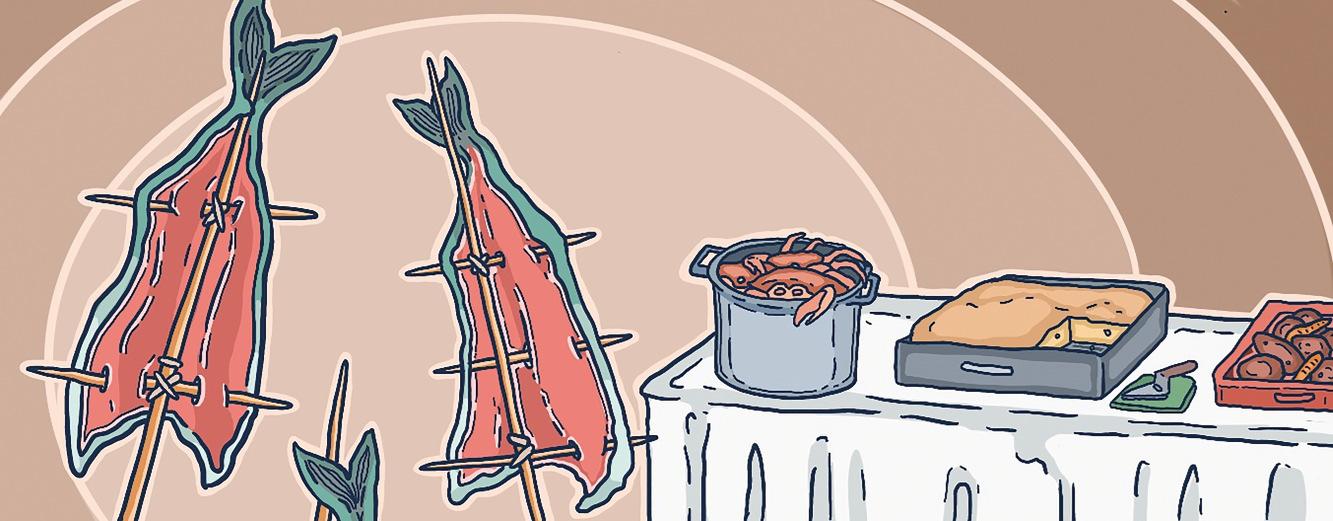
Illustration by Koyah Morgan-Banke
Nora O’Malley photo
Westcoast Community Resources Society’s SexualAssault Response Program co-ordinator Jenna Pearce, left, and executive director Laurie Hannah want community members to speak up about sexual violence.
Two women given King Charles Coronation medals
Cyndi Stevens and Jeanne e Wa s receive medals from MP Gord Johns at the Port Alberni Friendship Center
By Denise Titian Ha-Shilth-Sa Reporter
PortAlberni, BC – Two Nuu-chah-nulth women were awarded the King Charles medal in recognition of their decades of service to the community. Cyndi Stevens and Jeannette Watts received medals from MP Gord Johns at an elder’s dinner at the PortAlberni Friendship Center on November 12.
The King Charles III’s Coronation Medal commemorates the Coronation of His Majesty King Charles III as King of Canada. Eligible candidates must have made a significant contribution to Canada or to a particular province, territory, region or community in the country, or have made an outstanding achievement abroad that brings credit to Canada.
There are 30,000 medals being awarded across Canada. Johns said that he was tasked with nominating 20 people in his riding for service in their communities.
Prior to official business,Ahousaht elder Wally Samuel welcomed the people and acknowledged Tseshaht and Hupacasath First Nations, in whose territory the event was held.Amoment of silence was observed for former B.C. premier John Horgan, who died earlier that day.
Johns said they were there to share a meal with the elders and “to honour two amazing women who have contributed immensely to the individual, family and community health and well-being of Indigenous people.”
He praised both women for their selfless commitment to the community and making a difference in the lives of so many.
First to receive her medal was former NTC Nursing Manager Jeannette Watts.
“In recognition of your leadership in nursing care for Nuu-chah-nulth people, on and off-reserve, for more than 36 years, and for your contribution to providing culturally safe health care with a focus on partnership and listening to the voices of the people,” said Johns as he pinned the medal on Watts.
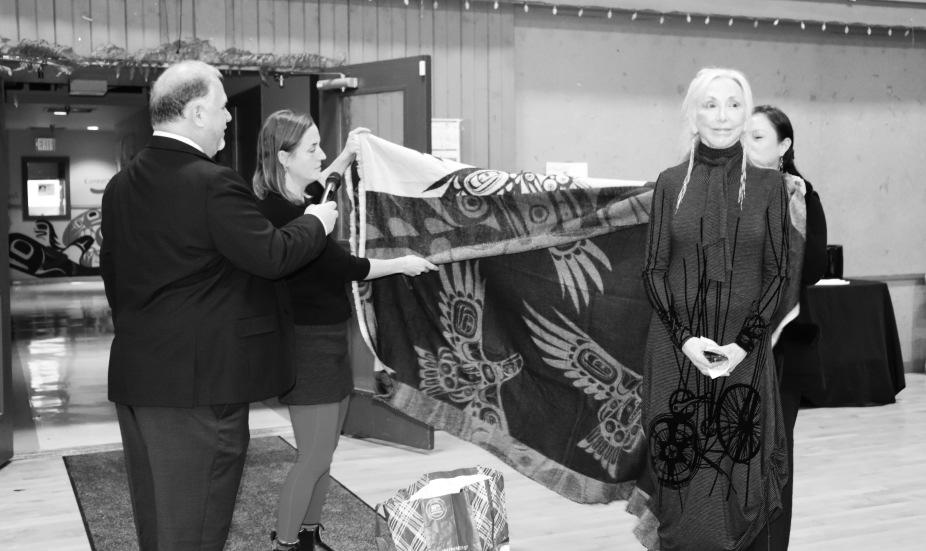
Jeannette Watts was blanketed by NTC nurses and thanked them and the elders in the communities who helped guide
in a 40-year career in nursing and administration.
Johns recognized Watts for following the guidance of the elders, “that each person be treated as if they have the answer within while nurses help them navigate their way, rather than just telling them what to do.”
Watts was blanketed by NTC nurses and thanked them and the elders in the communities who helped guide her in a 40-year career in nursing and administration. She was instrumental in creating a health care approach based on First Nation’s values.
Cyndi Stevens, executive director of the PortAlberni Friendship Center, started as a volunteer back in 1978. Nearly 47 years later she continues to advocate on behalf of the community for programs and services offered at the PAFC.
She says she’s always stayed positive despite the challenges over the decades.
“I love this job,” she said, adding that the staff and community are like family.
Johns said Stevens is being honoured for more than 30 years of service to the
community, her work with various levels of governance, national organizations and societies.
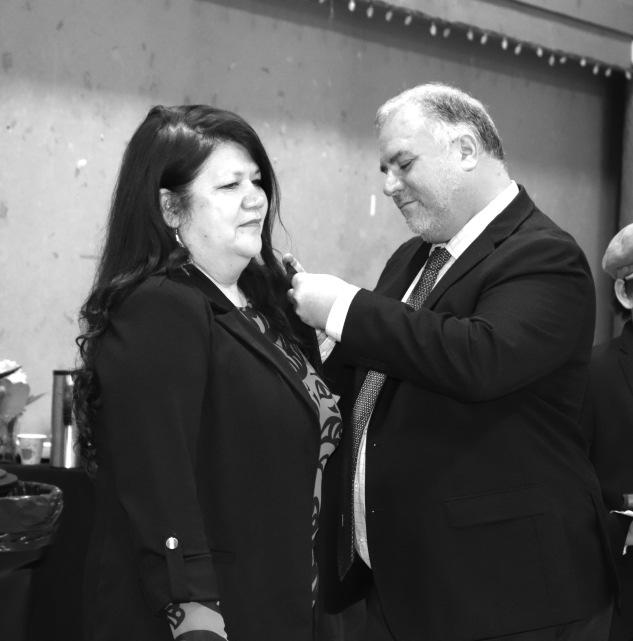
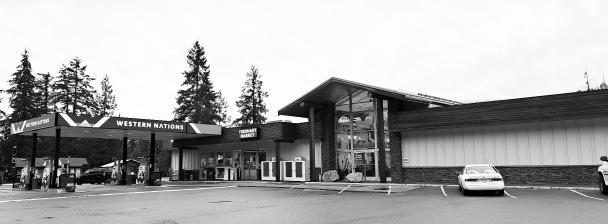


Denise Titian photos
her
Cyndi Stevens, executive director of the PortAlberni Friendship Center, gets a medal pinned on by MPGord Johns.
Hello Everyone. Hope everyone is doing well and making it through these autumn storms. I know we have lost more loved ones and my heart aches with you as you grieve. This past storm left many of our communities without power for several days and that is difficult. I hope all our communities are prepared for power outages with diesel generated power, wood stoves and lanterns. I know some communities fed people to ensure everyone could eat. Such great efforts to make sure our people were cared for. I work for the day when each of Nuu-chahnulth Nations are electricity independent, off diesel except emergencies, and creating enough clean energy for their needs. Also having our own micro grids that can be fixed quickly to supply power back to your homes and buildings.
It has been a busy month with many different issues to address. The executive of the NTC and the directors met with the deputy minister of Mental Health andAddictions, other B.C. government representatives, the First Nations HealthAuthority and Island Health to explore what they had to offer our First Nations during our state of emergency for the increasing number of deaths due to the toxic drug crisis and mental health issues. Even though it has been a month since our last meeting we didn’t have any commitments on money for the strategies and actions we want to put in place. After the election, Premier Eby did away with the mental health ministry and combined it with the Ministry of Health. That is a huge portfolio for the new Minister Josie Osborne. I will be setting up a meeting with her as soon as possible to follow through on the motion from the NTC on our state of emergency. As Josie Osborne is the MLAfor all but the northern region, we are hoping to get her help quickly as she is familiar with our issues.
I have been working with staff at the BC First Nations Justice Council to put in a proposal to start working on a justice strategy for those Nuu-chah-nulth Nations who want to work together. We hope to be doing community meetings with you in the new year to see what it is you want in a justice strategy.
I was able to attend a children and families conference in Vancouver at the end of October. First Nations people from all over Canada came and there were many workshops on how they are working with their children and families. Usma had a workshop on their parenting program that has Nuu-chah-nulth values and teachings throughout the curriculum. The curriculum was well received by the many that attended the workshop. I am also proud of our Usma program for receiving a ReconciliationAward for their canoe program and all the partners they made in putting together the program with the 8th Ave. Learning Centre and other community groups who contributed in many ways. Acouple of canoes were obtained and beautiful designs painted on them for children learn about going out in the canoes and other life lessons. The ReconciliationAward will be given in January at Government House.
The big news In children and families is that the chiefs from across Canada rejected the terms for the $47.8 billion settlement on future reform in the care of our children. The chiefs felt there was not enough input from the communities. There is much strategizing going on in how to re-negotiate this new agreement with new lawyers and negotiators and what is missing or needs to be changed in
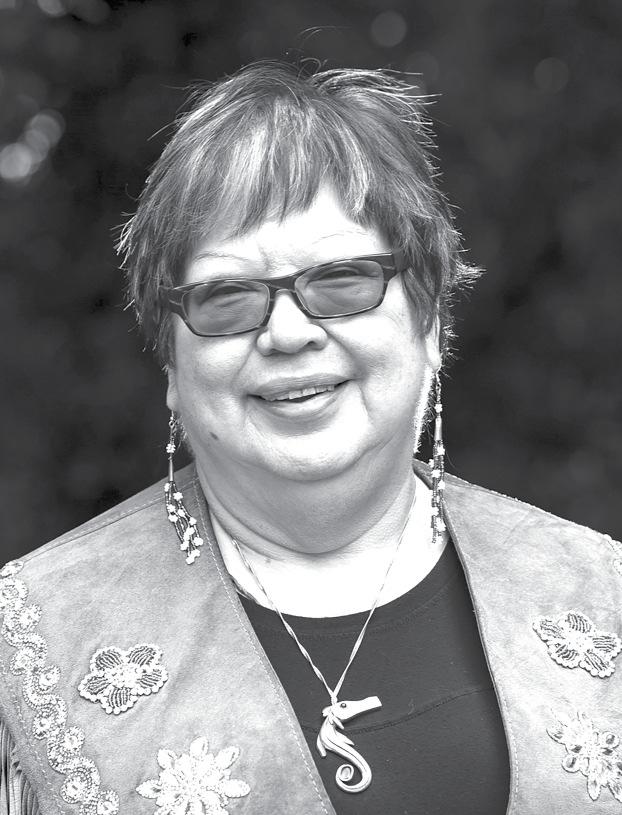
the agreement. It was not an easy decision as people were worried Canada may not come back to the table, especially if it isn’t completed before the federal election and if the Conservatives win.
I attended virtually the Council of Ha’wiih fisheries meetings. One of the issues with direction for DFO was herring. 2024 was finally a good year with herring coming back four times what it was in the past. Ha’wiih told DFO not to rush with commercial openings next year until it is proven that the conditions for the high abundance are stable.Also, the Ha’wiih pointed out that the work to determine what sustainable fisheries look like for WCVI fisheries still needs to be completed. That is what fisheries are most appropriate between spawn on kelp, seine and gillnet. The Ha’wiih do not want to see herring decimated; management takes time and data. The Ha’wiih discuss many issues and have their partners like the First Nation Fisheries Council and the Island MarineAquatic Working Group report to them. Often research groups present and this time it was on sea otters with a lot of different information. The salmon allocation review was discussed as was the chinook rebuilding plan.
This week we had our NTCAGM where all the departments have prepared written reports. Our audit is approved. ‘Sharing our successes’is our theme to report on what good things are happening in our communities.
As you know, Premier David Eby won a majority government in a hard-fought battle. He appointed a new cabinet - 17 out of the 24 ministers are women and four are Indigenous. Josie Osborne, who we deal with regularly, is now minister of Health. The former Health minister Adrian Dix now heads up Energy. Mines is now a separate. Mike Farnworth is now Transportation minister, which becomes very important in light of the highway closures and need for alternate routes within Nuu-chah-nulth territories. There is a new minister of Indigenous Relations and Reconciliation, Christine Boyle. There are many new faces to work with and continue the work we have been doing for the past four years on the United Nations Declaration on the Rights of Indigenous Peoples.
As we move into the holiday season, however you celebrate, Winter Solstice, Christmas, I wish you the best with many warm memories of those who have left us and making new memories with those who are with us now.
Cloy-e-iis, Judith Sayers

Tseshaht Lightning Junior Basketball Tournament
November 29-December 1
Maht Mahs
Divisions U13-U17. Join us for an exciting weekend of Junior Basketball. Contact Ed Nasimius Ross 250-735-2854
Nuu-chah-nulth Baby Group
Every Monday
CYS - 4841 Redford Street, Port Alberni
10am-12pm. We offer Prenatal and infant development information, special guests, snacks provide and $20.00 food voucher per family. 250-724-3939. Enter from 4th avenue side, building with orange stripe.


President’s Message &Community Beyond

Eating in Balance
Wednesdays
PortAlberni Friendship Center
Participants will receive a $10.00 grocery coupon that can be used at Quality Foods and Buy Low Foods. Open to all families with children 0-6. To register please contactAmber at 250-723-8281 ext. 233
GCultural Brushings with Quu asa
Every Friday
RedfordAdministration Building, Port Alberni
9:00am-12:00pm Cultural Brushings in support of the Tseshaht Community. Please call 250-724-1225

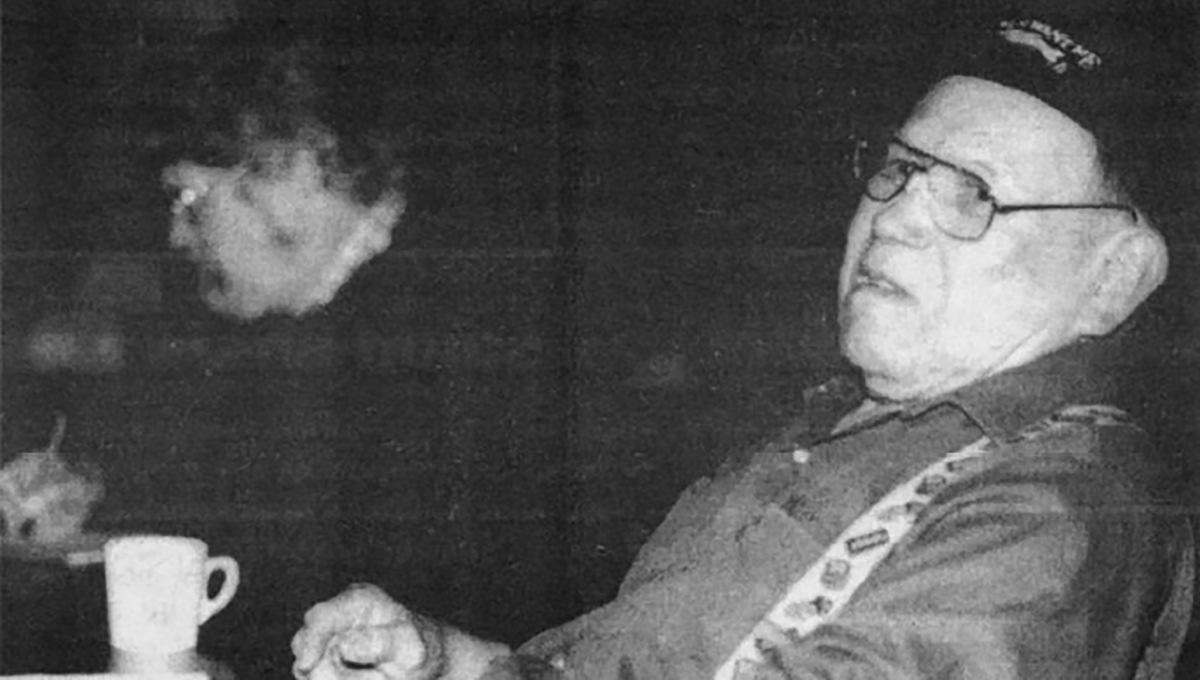
Anthropologists research traditional fisheries
25 years ago, Community members gathered at Hupacasath Hall to share their stories on traditional Nuu-chahnulth fisheries. These stories provided information to three well-known Canadian anthropological researchers. Through archival documents, photographs and stories Drs. Barbara Lane, Kevin Neary and Jim Haggerty had found more than 110 shellfish, 50 fish, and 20 mammal species that were
utilized by Nuu-chah-nulth people for food and other means. Toquaht elder Archie Thompson shared his knowledge, with the purpose of benefiting future generations. Intertidal trading was the currency, and each species was treasured. “We had many clam beds, and areas where we could gather gooseneck barnacles, oysters, and red and black chitons. When the tide was out, our table was set,” said Thompson.
Photo caption: Toquaht elderArchie Thompson (with Dr. Jim Haggerty in background) spoke on the names of many important places in Toquaht territory

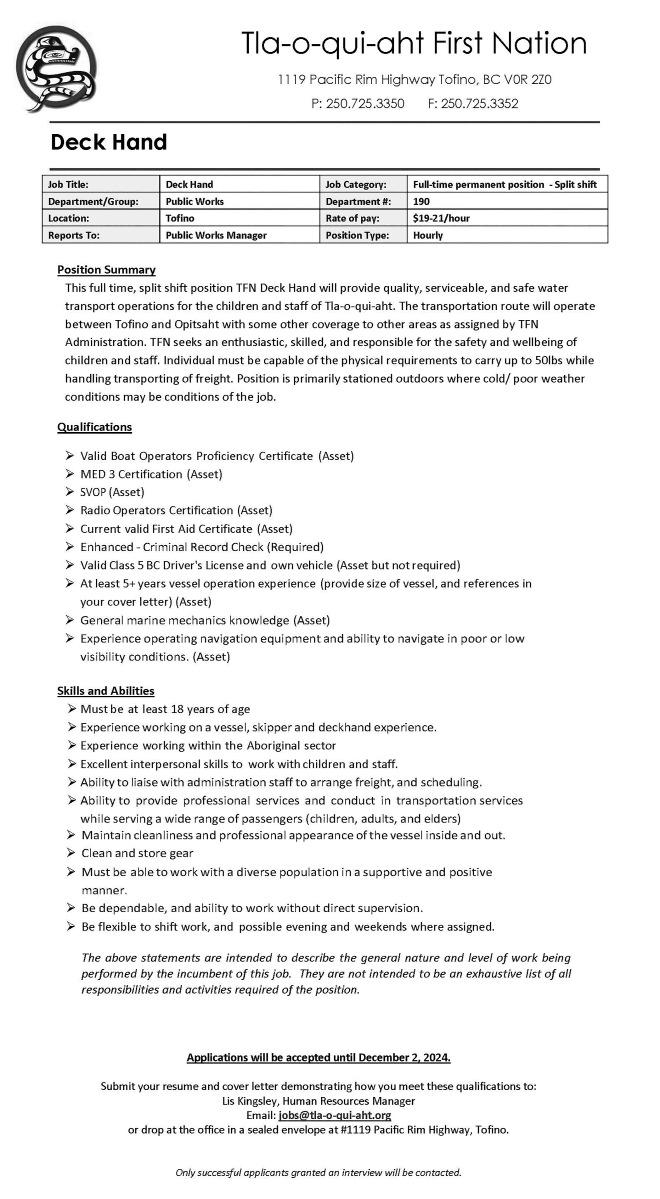

Port Alberni Friendship Centre Volunteers Needed
Need work experience? The Port Alberni Friendship Centre is looking for interested applicants for various positions. Call 250-723-8281

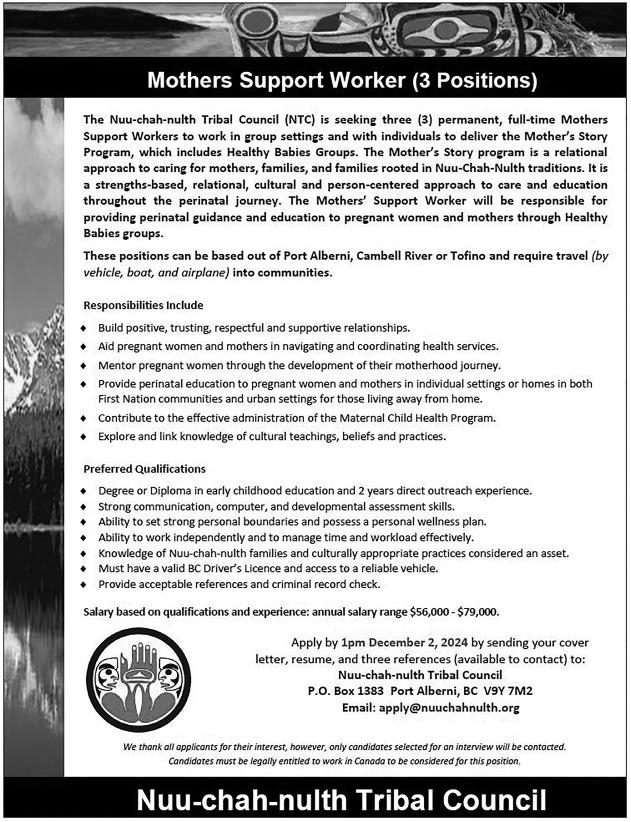
Satellite imaging assesses kelp changes over time
‘Kelp
doesn’t like warm oceans,’ says researcher Maycira Costa, who works with First Nations to monitor ocean
By Sam Laskaris Ha-Shilth-Sa Contributor
Victoria, BC – Several Nuu-Chah-Nulth First Nations are expected to benefit from the news that a professor from the University of Victoria (UVic) has been given a prestigious position.
Maycira Costa has been named the BC Leadership Chair in Environmental Remote Sensing.
“It’s a huge deal,” Costa said. “It’s kind of a very prestigious position. In the field of remote sensing, using satellites to monitor the earth, I’m the only person in British Columbia with this focus. I think it will open many doors in terms of how to support the Indigenous people and communities.”
Costa, who has been teaching at UVic for the past 23 years, said a former colleague at the university previously held the BC Leadership Chair in Environmental Remote Sensing position. But he retired about a half dozen years ago.And the position had been vacant since then until Costa’s appointment last month.
Besides teaching, Costa is also a geography researcher at the Victoria university. She will have a new focus now.
“This is a program that the province has and they have some endowment funds that support those research chair positions in British Columbia,” Costa explained. “I was awarded one of these positions and the goal of this position is for my team to enhance this research that I’m conducting right now, looking at change in the marine system, not just the coastal system but the ocean in general.”
Costa already heads up a substantial research team at UVic.
“I have a very large research lab right now,” she said. “And it will get even

bigger now because I will have more time to dedicate to research, more time than I had in the past. Right now, I think I have around 15-17 people in the lab.”
That includes lab assistants as well as all types of students, including undergrads, those completing masters, PhDs and postdocs.
Working alongside representatives of various First Nations in the province is nothing new for Costa.
“Alot of the research we do right now is really focused on the coastal ecosystems in British Columbia,” she said. “And all of the projects I have right now are with First Nations.”
The Nuu-Chah-Nulth First Nations that Costa is already working with are Toquaht, Nuchatlaht, Mowachaht/Muchalaht, Huu-ay-aht andAhousaht.
Costa’s current research work, which
will now continue with her new position, includes looking at changes on kelp.
“We have a lot of meetings to really try to build this collaborative work where we address issues or interests of the First Nations in regards to those ecosystems that we are focusing on,” she said. “The west coast of Vancouver Island, which has some of those nations, are very interested in defining, for example, and they could start to restore some habitats for kelp. Kelp has disappeared or it is very sparse right now.”
“Other areas are trying to identify regions where they can wild-harvest kelp, or even some of the nations are trying to come up with some ideas for kelp agriculture in their territories,” she continued. “And then as part of my research, I look at the kelp and how it has changed over time because I get a lot of satellite images
that have been acquired since the ‘70s.”
Costa added her research also looks at environmental conditions of locations in an effort to try to identify the reasons a specific area has lost kelp, where it is decreasing or where it is stable.
“This can be related to ocean temperature changing because kelp doesn’t like warm oceans,” she said. “It can be related to wind conditions. It could be related to marine heatwaves. Or it could be related to increasing sea urchins in the area.”
Work is being accomplished because of collaborations with First Nations.
“I’m learning a lot with them,” Costa said. “And they’re learning a lot with us. It’s this combination of how to move forward because they know a lot. It’s incredible when we’re in the field with them, we learn so much from their experience. If I just look at the satellite data I can come up with some ideas.”
“But they have information that only a person who lives in the area and lives there all the time, they’re able to interpret that information better. When we are with them, we both learn a lot.”
With her new leadership chair position, Costa said she’ll be able to take her work to another level.
“It will help me to start to implement these kinds of methodologies that make the communities, the nations, more independent on how they can extract information from satellite images,” she said, adding there will be less of a reliance on her to download and interpret data. Costa believes benefits will be seen down the road.
“It’s a path that we have to follow and it’s not something that will happen in the next month or so,” she said. “It will take few years. But it’s something that I think we will succeed in doing it together.”
New centre will highlight ecosystem restoration
By Karly Blats Ha-Shilth-Sa Contributor
Ucluelet, BC -Anew stewardship centre in Ucluelet will educate and engage visitors through interactive activities and exhibits showcasing the relationship between human activity and natural ecosystems.
The project is led by the Redd Fish Restoration Society, a registered charity focused on ecosystem restoration, research and education. The project is moving forward through collaboration with the five nuučaanuł Nations located in Clayoquot and Barkley Sounds.
The new interactive tourism experience will go alongside a social enterprise business that is expected to benefit from the growing demand for eco-tourism experiences across the west coast of Vancouver Island.
The centre, still in its early stages of development, will include interactive exhibits, multi-media displays, interpretive materials and pieces on Indigenous stewardship.
“The stewardship centre will serve as a year-round and inclusive space that includes interactive interpretive displays focused on ecosystem restoration, regional history and ecology, and nuučaanuł culture and stewardship of these lands and waters,” said Jen Dart, operations and development manager with Redd Fish Restoration Society. “Displays will be both static and interactive, and the centre will include play areas, event space, a coffee bar and a gift shop. We aim to cre-
ate a space that will be welcoming to all, and utilized by locals, visitors and school groups.”
Dart said the project is in the very early stages of development and the society has presented to Ucluelet council and hope to begin other meetings with the First Nations soon.
“Collaboration with the nuučaanuł Nations in Clayoquot and Barkley Sounds on the stewardship centre will be similar to how we work with the nations on an ongoing basis,” Dart said. “We seek the permission of each of the nations to partner to complete restoration priorities in their hahuułi (territory), and this project will be much the same.”
As part of the centre, Dart said the goal is to have a rotating exhibit that would create opportunities for Nuu-chah-nulth knowledge to be shared.
“All educational content within the centre that speaks to nuučaanuł culture, knowledge and history will be told and described with permission and with the perspective of nuučaanuł individuals and nations,” Dart said.
The development is made possible from a new project investment with Island Coastal Economic Trust.
“The Redd Fish Stewardship Centre has long been the society’s goal to showcase the vital work we do in this area in partnership and with permission from the nuučaanuł Nations,” states Jessica Hutchinson, executive director of the Redd Fish Restoration Society in a press release. “It is exciting to share the restoration story with locals and visitors alike
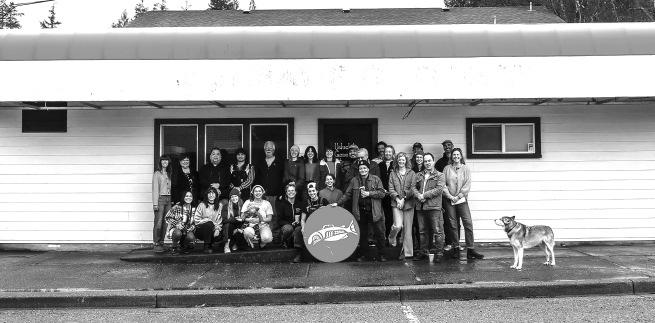
through the development of the stewardship centre, all while generating further investment and employment into local ecosystems.”
According to the press release, the Tlao-qui-aht First Nations, Toquaht Nation Government, Yuułuʔiłʔatḥ Government, the District of Tofino and the District of Ucluelet have all expressed support for this project and the society, which has an Indigenous-led board of directors and has operated on the west coast for decades. Earlier this year, the society purchased a property at 1728 Peninsula Rd. in Ucluelet that will become both the organization’s base of operations and the future home of the Redd Fish Restoration Stewardship Centre.
Revenues raised through entry fees, retail store and coffee bar sales, and space rentals is expected to create sustainable funding for the society to reinvest in new
coastal habitat restoration and employment-generating projects.
Over the past 27 years, Redd Fish has collaborated with five nuučaanuł First Nations to employ both scientific methods and traditional Indigenous knowledge to address environmental challenges effectively, states the press release. The society’s board of directors include representation from five nuučaanuł nations: Ahousaht, Hesquiaht, Tla-o-qui-aht, Yuułuʔiłʔatḥ and Toquaht.
Through the new centre, the organization aims to build on these relationships, while further integrating into the community to support local ecological, cultural and economic development. Their goal is to enhance local stewardship efforts and contribute to broader conservation goals.
The project, which will be underway this fall, targets a June 30, 2026 completion date.
Redd Fish Restoration Society
The Redd Fish Restoration Society is developing a new interactive stewardship centre at 1728 Peninsula Rd. In Ucluelet.
Submitted photo
Research from the University of Victoria is trying to find reasons why certain areas have lost kelp, where it is decreasing or where it is stable.
No commercial catch in 2025, despite herring growth
But opportunity awaits in Japanese markets, as Nuu-chah-nulth nations look to sell roe on kelp in late winter
By Eric Plummer Ha-Shilth-Sa Editor
Tsaxana, BC - Despite growth in herring populations, Nuu-chah-nulth leaders remain concerned about the long-term health of the species, opting again to not permit a commercial catch in 2025. But for the first time in several years, a spawn-on-kelp fishery is being planned by Ha’oom. Owned byAhousaht, Ehattesaht, Mowachaht/Muchalaht, Hesquiaht and Tla-o-qui-aht, the fisheries society hopes to capitalize on commercial opportunities in selling herring roe, or k̓ʷaqmis, attached to kelp in their respective territorial waters.
The volume of herring tracked on the B.C. coast has risen significantly in the past few years, a rebound from historic lows seen over a decade ago. On the west coast of Vancouver Island the calculated biomass has risen since being under 15,000 tonnes in 2018 to 65,500 this year. Almost 60,000 tonnes are expected to be off the west coast of the Island in 2025.
Reproduction has shown an even more marked increase, based on models that calculate herring spawn. Since 2015 the herring spawn index has risen from under 12,000 tonnes to over 86,300 this year, the largest seen on the west coast of Vancouver Island since the mid-1970s. Over the last few years the region’s most concentrated spawn has been in Hesquiaht, but in 2024 larger volumes were seen in other areas along the west coast. Herring spawn data from Fisheries and Oceans Canada shows 31,152 tonnes in Barkley Sound, 39,700 in Clayoquot Sound and 15,420 tonnes in Nootka Sound in 2024.
In late October DFO sent out a draft Integrated Fisheries Management Plan to various stakeholders to determine if and how much herring will be caught in 2025. The recent population numbers are well above the upper stock reference point, which is an average of the herring volume tracked in the 1990s that sets a benchmark for conservation considerations. But this did not sway the views of Nuu-chah-nulth leaders, and at a meeting in early November the Council of Ha’wiih Forum on Fisheries voted to keep the commercial seine and gillnet herring fishery closed for another year on the west coast of Vancouver Island.
“Ahousaht’s position is no, no fishery at all,” saidAndy Webster, a lifetime fisherman who representedAhousaht at the recent meeting, which was hosted by the Mowachaht/Muchalaht First Nation Nov. 5 and 6 in Tsaxana. “Just because we see some big spawning in Clayoquot Sound doesn’t mean there’s a lot of herring. There are spawning beds that are still inactive. Until such time that I see activity in the other ones, I think it should remain closed.”
Tla-o-qui-aht Fisheries ManagerAndrew Jackson expressed concern that a full-scale commercial herring fishery could reverse the recent population rebound.
“We’re happy to see it, we’re a little bit leery of harvesting activity in that they’re going to disappear again,” he said. “We don’t even have enough herring in our nation’s Ḥahahuułi for us to even have a food fishery.”
At the end of winter each female herring lays thousands of eggs that stick to underwater rocks, silt and kelp, awaiting the milky spawn from males – reproductive activity that turns parts of the ocean a lighter aquamarine colour. Traditionally, Nuu-chah-nulth-aht harvest this roe by
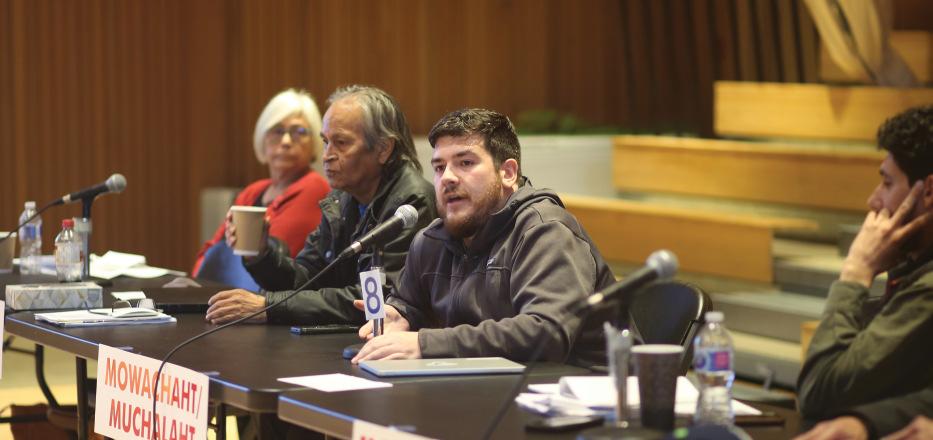
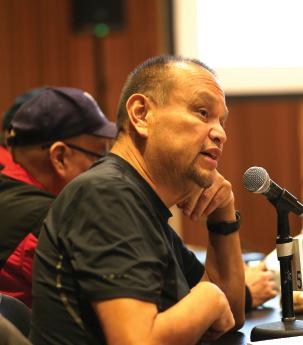
dipping branches in the waters thick with herring eggs, bringing up the beloved k̓ʷaqmis. But in recent years many Nuuchah-nulth nations have had to buy this delicacy from other Indigenous communities on the central coast of B.C.’s mainland.
It was just two years ago thatAhousaht could once again harvest an adequate supply of k̓ʷaqmis from its own territory, said Webster.
“For all the years that we went without, our people had to buy from Bella Bella,” he said. “Ayoung fellah used to come down and sell them by the buckets to the people that wanted to buy, at a big expense to our people.”
“Most of our k̓ʷaqmis still comes from the central coast,” said Nuchatlaht CouncillorArchie Little. “We’re not anywhere close to what we had. Nuchatlaht had herring and k̓ʷaqmis all year round, not just to feed when they’re spawning.”
Jackson said Tla-o-qui-aht won’t support a commercial herring fishery until members can get thick roe from their shores.
“We wouldn’t support until we see an adequate number back where our people can go and harvest at our front door, like we used to right in front of Opitsaht,” he said. “Stubbs Island, from Tofino to Opitsaht, used to be white when I was a teenager. The whole thing was white with spawn.”
The west coast of Vancouver Island hasn’t seen a commercial herring fishery since 2005, which was followed by years of the region’s biomass wallowing under 10,000 tonnes. Elsewhere on the B.C. coast, an annual commercial catch has usually only taken place in the Strait of Georgia, held for a few weeks each spring with the aim of catching females while they are full of eggs. The roe is
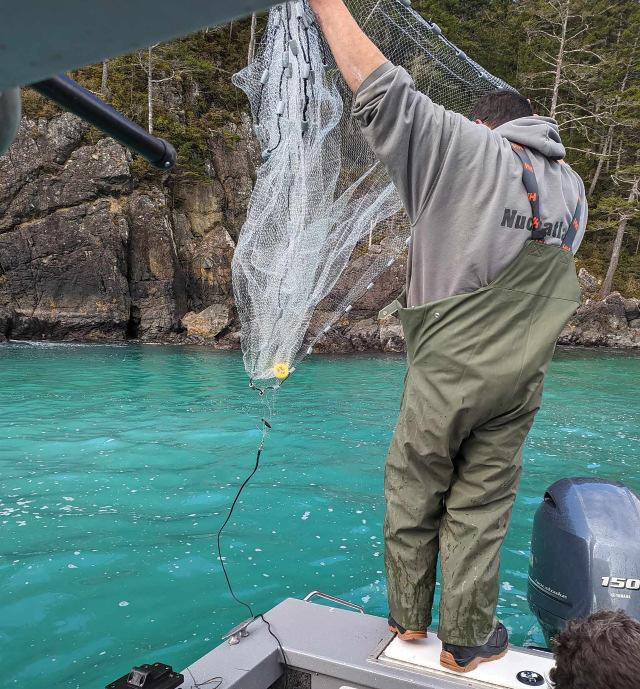
exported, mostly to Japan, while the herring fish are ground down into feed for livestock and fish farms. In 2022, $19 million of herring product was sold to Japan, comprising 71 per cent of the total value of the fishery’s exports from B.C., according to DFO reports.
Another lucrative part of herring fishing is spawn-on-kelp, most of which is also exported to Japanese markets. In 2025 theAhousaht, Ehattesaht, Mowachaht/ Muchalaht, Hesquiaht and Tla-o-qui-aht First Nations plan to tap into this commercial opportunity through the operations of its Ha’oom Fisheries Society.
“Because the stock has increased, it has been proposed by the five nations to potentially engage in a fishery of low impact, which is the spawn-on-kelp fishery,” said Kadin Snook, Ha’oom’s fisheries coordinator.
Snook said that licences would potentially permit the nations to harvest 16,000-48,000 pounds of the product from Feb. 1-April 30.
“This fishery is going to be a community-based, five nations fishery,” he said. “If successful, it will provide necessary revenues, and more importantly, information on how the kelp spawn densities are doing.”
The Council of Ha’wiih agreed to support this venture, plus existing spawn-on-kelp licences that are held by theAhousaht, Ehattesaht, Toquaht and Ka:’yu:’k’t’h’/Che:k’tles7et’h’First Nations.
Arecent letter from the Council of Ha’wiih to DFO stated research indicates that 78 per cent of herring that come into contact with a spawn-on-kelp operations survive, compared to none that are affected by seine and gillnet fisheries.
“I see this as a great opportunity, it hasn’t been done since the early 2000s, I think,” saidAhousaht member Richard Little, noting the urgency to prepare the necessary equipment for when kelp blades are thick with herring roe in a few months. “To make this work, we’ve got less than 100 days between now and mid-February when the herring is going to come into Sydney Inlet.”
The Integrated Fisheries Management Plan for Pacific herring is collecting input until Dec. 3.An approval from Diane Lebouthillier, Canada’s minster of Fisheries and Oceans, expected in early January.
Eric Plummer photo
Kadin Snook, fisheries coordinator for Ha’oom Fisheries Society, speaks in Tsaxana on Nov. 6, next to Mowachaht/Muchalaht Tyee Ha’wilth Mike Maquinna and Toquaht Ha’wilthAnne Mack.
Andrew Jackson
Anet is cast in Kyuquot Sound to collect samples of herring roe in February.
